
 Mouth of The River
Mouth of The River


 Mouth of The River
Mouth of The River
News

Class Bond/Calculus pg. 3 Osterloh pg. 5 College Tips pg. 7 Durham pg. 9
SAT Online pg. 11 Durham Business pg. 13 Orchestra pg. 15
College Scandal pg. 18 Self Care pg. 21 Cheating Follow Up pg. 23 Music pg. 25


Coaches pg. 27 College Sports pg. 29 Fashion pg. 33
As we wrap up the final issue of Mouth of the River for this school year, this year’s staff of incredible writers, coordinators, designers, and investigators continues to blow me away. I am confident in the work that we have produced this year and believe that we have represented the events that have occurred Oyster River Cooperative School District well.
One of our biggest goals as a staff this year was to promote more multimedia stories and I am proud to say, we delivered. Grace Castonguay and Joe Morrell have continued to tradition of making a Senior Legacy video which features many graduating seniors answer ing questions such as, ”What would you tell your freshman self?” and, “Who would you like to thank?” I encourage you to take a look at this video to celebrate the graduating class of 2019.

Continuing these sentimental senior feelings, Phoebe Lovejoy reflected on her college application process and collected other senior’s experiences in her piece titled “What to Expect When You’re Expecting (To Apply to College).” This piece ties together many of the important details that are helpful to know if you decide to pursue a higher education. In keeping with Mouth of the River tradition, Abby Schmitt profiled seniors continuing to play sports at the collegiate level. From baseball to crew, the mini profiles cover where the students will be attending this fall as well as their inspiration for continuing their sport.
In another article, Susanna Serrano dove deep into the history of Durham and highlighted a few of the influential people and events over the past three hundred years. I loved reading this article because not only did I learn about the town that I have lived in my whole life, but I enjoyed hearing the testimonies of people who lived in the Oyster River community.
Our cover story is based on Carola Davis’ article about self care as well as Phoebe Lovejoy’s fashion article. Photographed by Joe Morrell and Phoebe Lovejoy, we hope you enjoy our spring-like, joy-filled cover.
There are countless more articles in this final issue of Mouth of the River, each one bringing an unique perspective to our readers. I am incredibly grateful for the opportunity to be Editor-in-Chief this past year. I have learned so much about communicating with others, writing stories that are important to myself, and growing the existing magazine. Thank you so much to all that have helped Mouth of the River this year by subscribing, sponsoring, and supporting.
With pride, I encourage you to enjoy a new issue of Mouth of the River
Warmly, Jordan Zercher
Editor-in-ChiefMOR Mission Statement: Mouth of the River seeks to reliably inform the student body, as well as the surrounding community, of interesting and newsworthy content in a modern, compelling format. Our goal as a staff is to give a voice to the students of Oyster River, and have it heard by all of our students. The opinions expressed in Mouth of the River represent those of the writers and staff.
Website: mor.news • Email: mouthoftherivermagazine@gmail.com
Instagram @mormagazine • Twitter @MORmagazine • Youtube @MouthoftheRiver
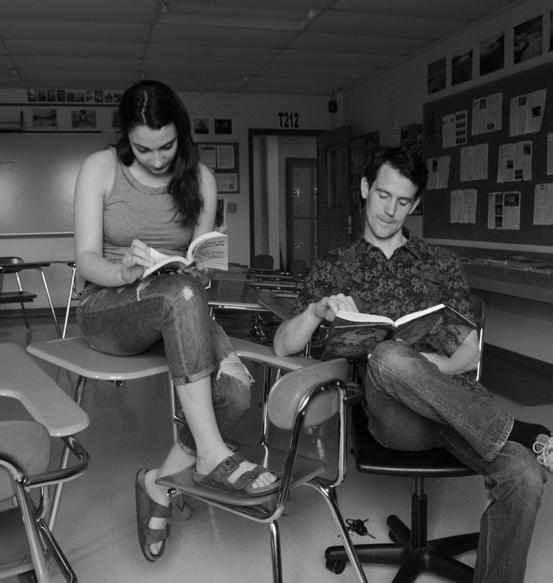
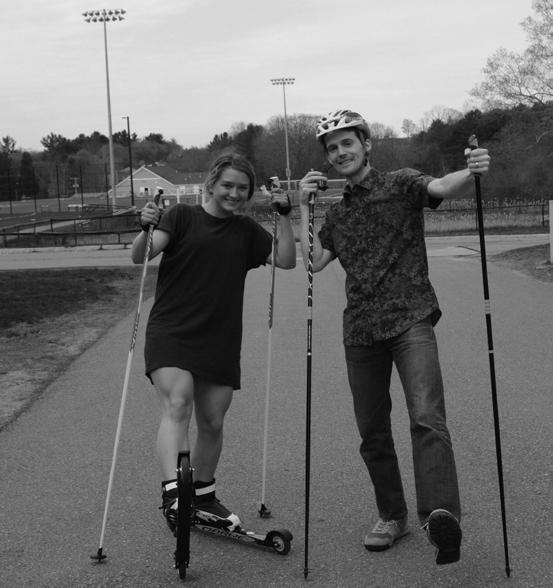

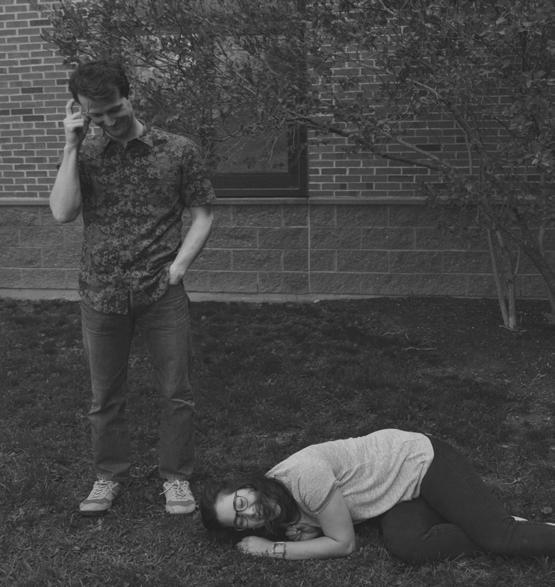
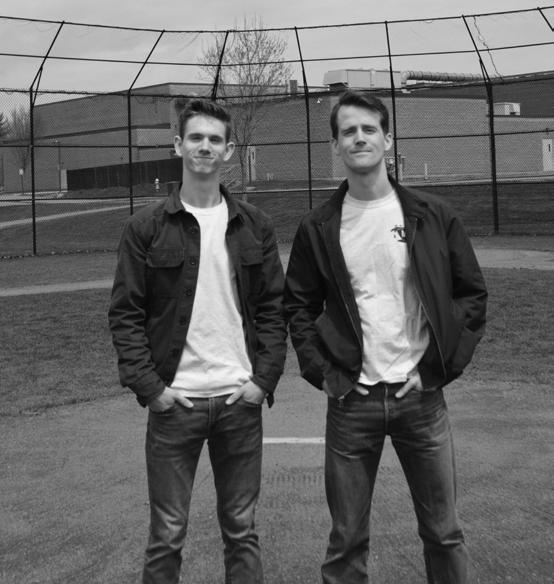
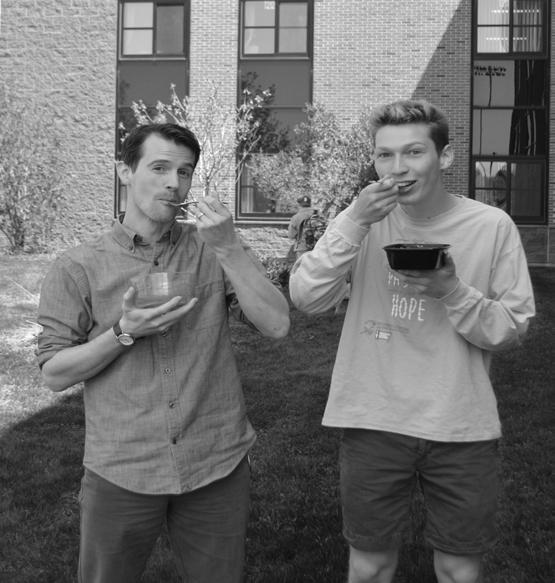

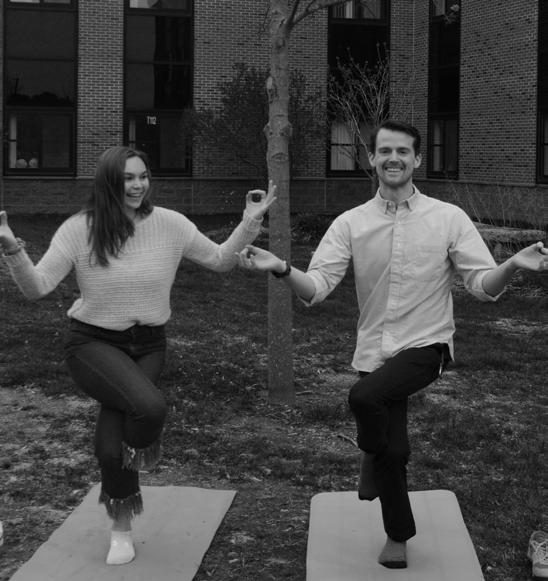
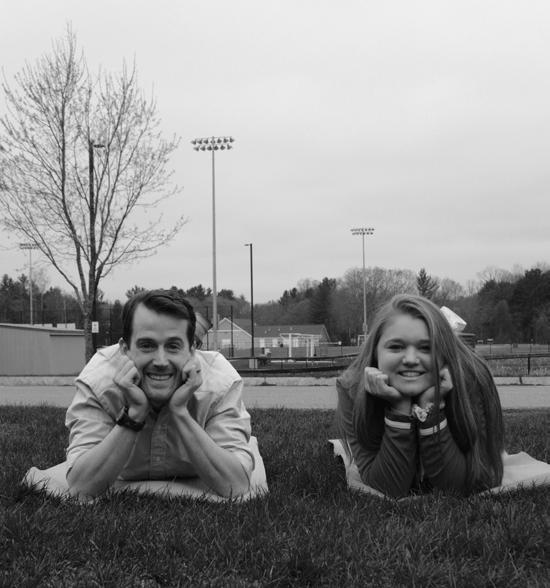
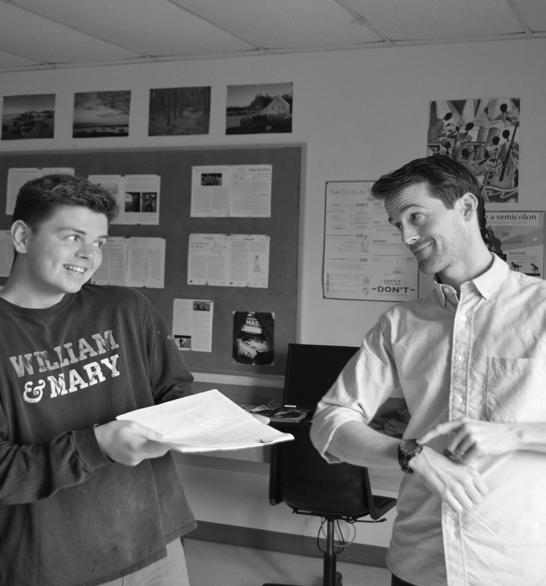
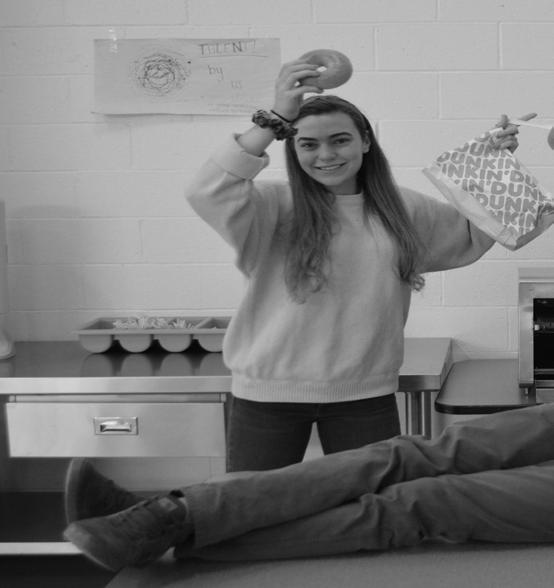
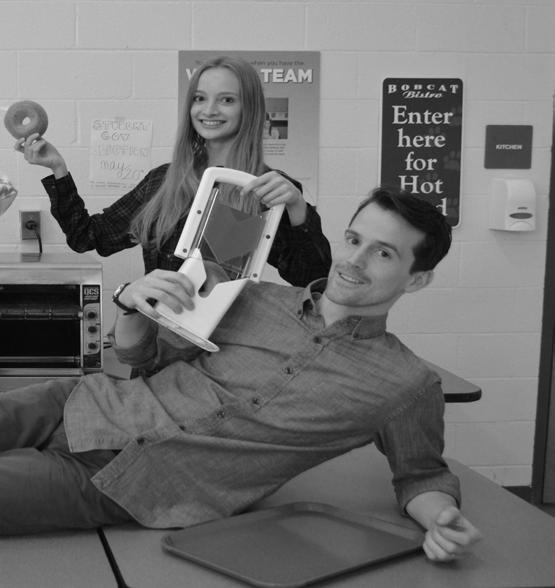
“The class is very unusual. I have no idea why this has happened,” said Bill Reeves, math teacher at Oyster River High School. Beginning within the first week of school, Reeves’ B-period AP Calculus class began to develop a bond unlike any class he’d seen.
“Some of us were already really good friends, and we’ve all been in similar math classes. We all bonded together for some reason over not only the fact that math class is hard, but also because we enjoyed it, each in our own ways,” said Jane Spear (‘19), a member of the calculus class. Since the beginning of the year, the class has gathered together for a variety of reasons outside of class, including study sessions and celebrations for Thanksgiving, Christmas, Valentines Day, and Pi Day. On Halloween, members of B-period Calculus could be seen walking the halls dressed as math terms such as ‘the Chain Rule,’ ‘a horizontal line,’ and ‘extrema.’
As a graduating senior, I’ve been a part of more class communities than I can count, yet I still can’t quite put my finger on what makes a class click. Corey Blais, English teacher at ORHS, gave insight into her experi ences with students’ relationships in classes. “I think it’s all about the personalities in the class, how many people are friends, and whether that friend group has natural leaders,” she said. “If there is a personality that is a natural leader then other people start feeling more comfortable, which encourages people to speak because it feels like a safer spot,” she added.
Along with the reasons for class dynamic, Blais weighed in on the outcome of a close class saying, “it depends on what way they’re close. If they’re close in a very distracting way, it can sidetrack things a lot. If they’re bonded together in a more positive way, then it definitely improves the learning because more people are going to contribute and more people are going to participate.”
In my experience, B-period Calculus has encouraged students to contribute to conversation both in and out of the classroom. Spear explained how the dynamic began, saying, “we got together and laughed and related to each other’s stories. Before taking the class, we didn’t know each other well enough to know a lot of really personal things about each other, so it was interesting to be a part of all these different social groups
and really get to know each other and laugh about old stories.”
Olivia Colarusso (‘19) agreed, explaining the benefit of having a supportive class on her ability to learn, especially in regards to the complex material that AP Calculus covers. “I’ve never been in a class like this where we’re all so close. It really makes the class a lot more fun and I look forward to being there.”
Charlie Haskell (‘19) has also seen a difference in her under standing while being a part of the class. Due to scheduling conflicts, Haskell moved from B-period Calculus to F-period Calculus during second semester. “I learned much easier in B-Period, and my grade was better. It’s a much better learning environment for me because I feel more comfortable asking questions and feel less self-conscious about not understanding concepts.”
A member of F-period Calculus, Bhargavi Nimoji (‘19), has heard quite a bit about the differences between the two class periods. “I’ve heard that [B-period Calculus] is a lot closer than our class, and that [their] group chat is always going off,” she said.
Sam Johnson (‘19) explained that class group chats are a common part of the culture of difficult classes. “Most of my classes, especially higher level and AP classes, have group chats, which helps people stay on top of things.” He attributed the bond between students in B-period Calculus to the difficul ty of the material. “When you expose a group of high school students to a similar level of pain, they tend to bond together,” he said.
Along with the rigor of the course load, Felicia Drysdale (’19) also believes that having a teacher that is committed to creating a positive learning environment is also a big part of why the class is so close. “Mr. Reeves has a big part of our class bond because he’s always making jokes which triggers us to make jokes, which makes our class way more fun than any other class,” said Drysdale. “I think our bond is something that will never break. We all are very different people, but we have a lot in common that we didn’t realize. It brings us together because we’re all so different, and it makes us a fun group to be around,” she added.
Spear agreed that Reeves is a big contributor to the class environment, saying, “Mr. Reeves knows calculus really well, and he often uses real-world examples and applications of cal culus that we can relate to.” After a few months in

“When you expose a group of high school students to a similar level of pain, they tend to bond together.” -Johnson
calculus, Spear participated in a 14-hour math challenge along with Jordan Zercher, Phoebe Lovejoy, and me. “When Phoebe saw a math challenge poster in the hall, we decided to do it because math was now something that we were excited about,” Spear explained. Our team was the only team from Oyster River High School to compete, and we placed in the top three teams overall for our math challenge video as well as in the top 20% of solution papers.
Along with participating in the challenge outside of school, students in calculus also frequently meet up after class for study sessions and homework help. “[This class] definitely continues the conversations about math beyond the classroom,” said Reeves.

Teachers across all departments at Oyster River High School have taught diverse cross sections of students, each with a unique class personality. Shauna Horsley, English teacher at ORHS, explained that there is an element of ‘chemistry’ between students in a class that determines how they will interact. “I have had sections of a class where the chemistry just wasn’t there, so regardless of the setup of the class, the bonding wasn’t going to happen. There are certain classes that lend themselves toward [bonding], and they often are very student centered where there is autonomy and opportunity for students to work with each other and rely on one another,” explained Horsley.
Horsley agreed with the sentiments of students in B-period Calculus that the rigor of a course also contributes to the connections between students. “When people are challenged, they tend to rely on each other either for academic or moral support, so by default, students are reaching out to each other after class to ask questions,” she said.
Along with course rigor, the material that is being covered is also a factor that Horsley has seen in her classes. “In classes like Women’s Literature, I tend to have groups that bond really well, and I think that’s because of how real some of the topics are that we talk about. We’ll dive into issues that we might not talk about in other classes and I think through a lot of discussion and trust which can be established through talking about some of these things, peo ple tend to open up more and that leads to a [closer class],” she added.

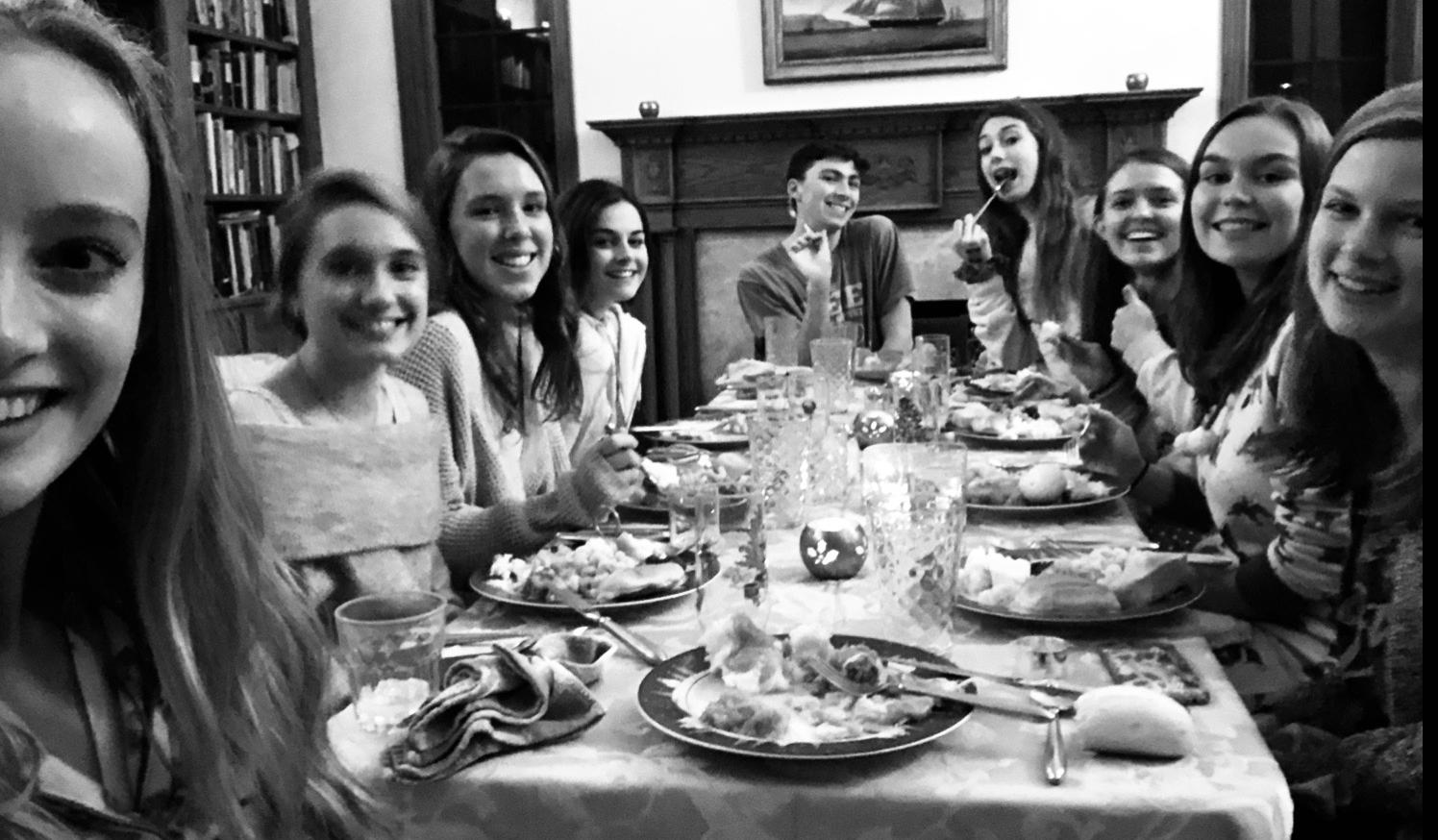
Michael Szymanski (’21) agreed, saying, “I have definitely had classes where we’ve got really close, especially in classes where you’re dealing with more [intense] subjects.”
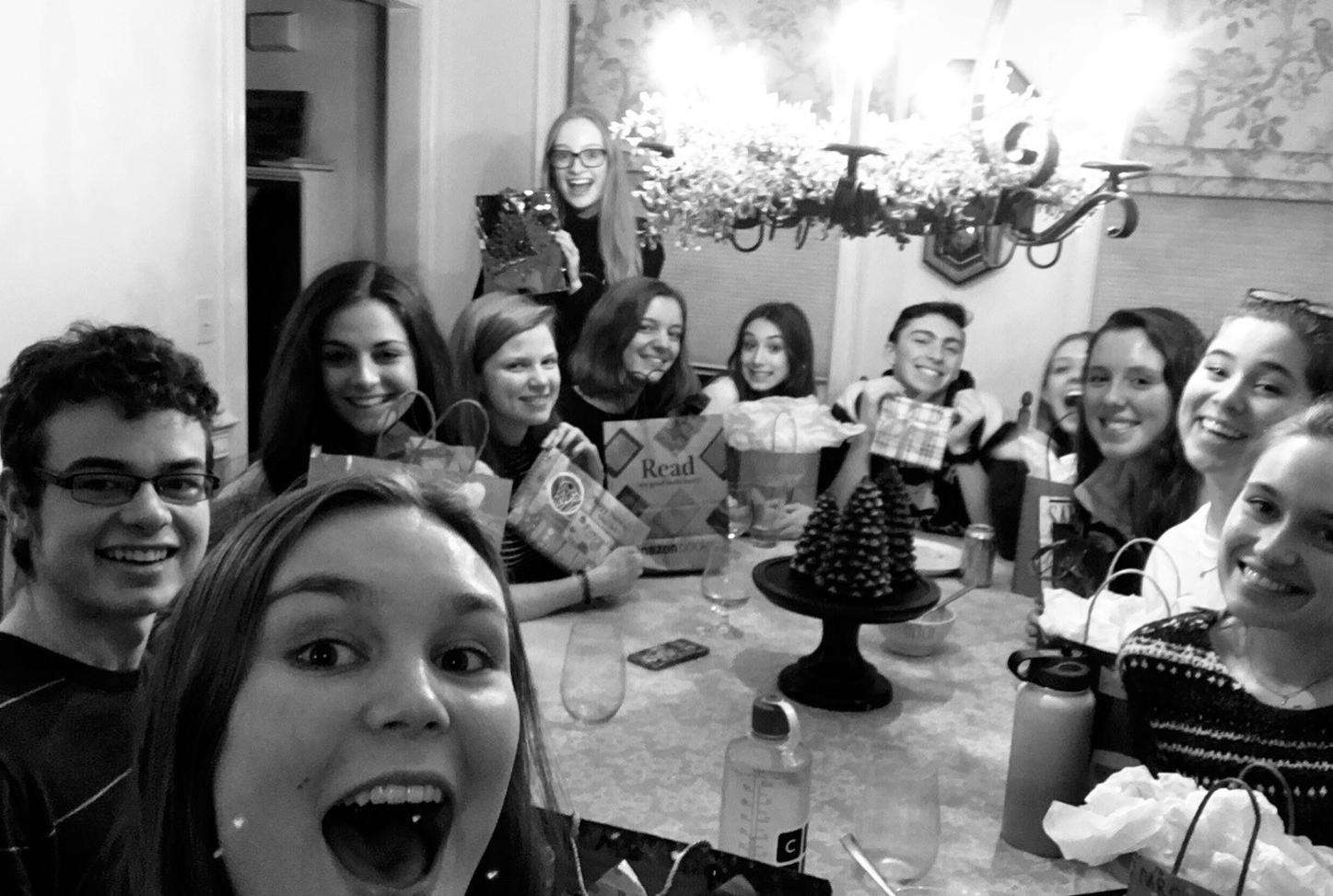
Szymanski also added that classes with students from the same graduating class are also more likely to connect, saying, “as a sophomore now, I would definitely say that there were more cases of bonding classes because each class was all freshman. When you’re in a class with just your age group, there’s more opportunity to connect.”
Regardless of what exactly brought B-period Calculus so close together, the students are excited to finish the year with a group of people that are there to support them. “It’s something weird that brought us together and now we’re just this whole group of friends that are having fun,” said Spear.
As Sandra Osterloh stands behind her counseling office desk, the high school registrar’s heart yearns for travel. The self-pro claimed wanderer has buzzed around the counseling department for the past six years, scheduling students, managing data and demographics, and keeping things running smoothly. This July however, Osterloh and her husband will be traveling to Yan gon, Myanmar to fulfill a two year contract at the International School of Myanmar. Osterloh will be serving in an administra tive position while her husband will be teaching science. While moving halfway across the world might seem like a daunting and somewhat terrifying task, Osterloh is no stranger to travel, culture or different languages.
Osterloh’s nomadic personality began at a young age. At three years old, the Oregon native’s family moved to Tunis, Tunisia where she attended a French kindergarten and later the American Cooperative School of Tunis. It was here that Oster loh learned French, Arabic, and English. By the time she moved back to America at age eight, the elementary schooler had a lot to learn about how to live in the U.S.
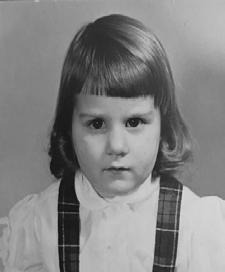
“A big part of who she is comes from her background: grow ing up on ranches in Oregon and living in Tunis, Tunisia for five years both played a part,” says Osterloh’s husband, Doug. After living in Tunis, Osterloh lived in Oregon through high school, and then attended college in Oregon where she met her hus band. Five years after marriage, the couple gave birth to a son and daughter while living in Eastern Oregon as Doug attended law school.
The yearning to wander returned soon after. Osterloh recalls, “when [Doug] was getting ready to graduate from law school, we decided we wanted to have an adventure. He ended up get ting a job in Hawaii in Honolulu and we lived in Hawaii for five years.” While living in Hawaii, the Osterloh family slowly grew as they fostered children, and eventually adopted two daugh ters: one they had previously fostered and one through a private adoption. “We were once the couple that was never going to have children. Things change,” Osterloh laughed off.
Travel has never been about tourism for the Osterlohs, and they’re not the people that just sit by the pool. “We try always to experience the local flavor of any place that we visit. We try to experience as much as we can and connect with the most amount of people… When we went to the Dominican, there was a rock wall on each side of the resort and it’s an all inclusive resort. And the first thing they told us was to not go on the other side of the wall. So that was the first thing we did,” says Osterloh.
Living became too pricey to raise a family in Honolulu, as it was expected that the children attend private school when they got older, so the family returned to the continental U.S. to live in Washington for eight years, then back to Oregon. In 2006, they finally to moved to New England. For one year, Doug took a government job in Boston until he decided it was time for a career change in the field of education.
For the past 13 years the Osterlohs have resided in Kingston, NH. Doug settled into a science teacher position at Bradford Christian Academy and Osterloh fell in love with her job at Oys ter River as the high school registrar. Both are advanced EMTs and share pride and joy in helping others. “We both are madly in love with our jobs… ” she shared.
And then, Osterloh’s life changed. “Last summer, my brother unexpectedly died at the age of 66 and that changed my life big time. It really had an impact on me about just how fragile life is.” From working on the ambulance, Osterloh and her husband have witnessed life and death, so they are no stranger to trauma, but regardless of this, losing her brother was difficult. “We see some really sad things. It’s easier to be clinical about what we see on the ambulance than it is to have your eldest brother die.”
This event sparked serious conversation between Sandra and Doug. The kids were grown up, all living in their own corners of the world. The couple had always shared a plan in which Doug would teach internationally and Sandra would follow him as a ‘trailing spouse.’ “I looked at my husband and said, ‘What are we doing? Why aren’t we doing this now? Why would we wait three more years? We’re at a place in our life where we can make this decision.’” After thoroughly discussing the possibili ty, they decided to cast the net wide and if it worked out, they would go.

After preparing the mountain of paperwork for each of the agencies, interviews started coming in from Ecuador, Senegal, Bangladesh, and India. “The International School of Myanmar

Osterloh’sfirst passport photo.
“I have learned in my life to never say never….It’s not always about getting paid. It’s just about what you do with that in your life...”
interview was spectacular… The principal that interviewed my husband hired him within two days and made him an offer.” Osterloh was especially excited because the school documents that they do hire ‘trailing partners,’ the spouses of hired teach ers, whenever possible. “I will work with the principal and the counseling office, and I will be handling all of the school testing, and then also maintaining their Facebook and website. I will probably be working and assisting the registrar with records,” she explains.
Over the years and from each of the places, Osterloh has learned a lot about life and culture as a whole. “Under the color of people’s skin, and under the accents, and under the other language, you can still communicate, regardless of knowing the language. I’ve just learned that all cultures seek to be accepted. I think that’s what mankind wants…” Osterloh has tried to instill this ideology in her children by showing them as much of the world as possible though travel. It is clear that it is a big part of who she is. Doug noted that his favorite part of Osterloh is, “her confidence, and her willingness to try something new… like moving halfway around the world to live and work in a totally new culture.”
“The biggest thing I’ve learned in the last three months is that material possessions are overrated. Too much stuff, too much junk, and too much money spent on things,” says Osterloh. They will be storing everything they own in a 10 foot by 15 foot storage unit for the next two years. When the Osterlohs leave for their twenty-four hour flight, they do not have the option of shipping things over and will be traveling with only suitcases, prioritizing the essentials like medications, and bug spray for a whole year. They will restock when they visit the U.S. in one year between the two year contract.
She is excited and thrilled for the opportunity but is also aware there will be a transition period. “I know there will be a learning curve. Having lived in Hawaii, it’s a much slower pace of life, and that can be a challenge for a very driven person like myself. I like to start tasks and complete them. In Hawaii, there were times where that was hard for me to have the Shaka Brah kind of mentality.”
For reference, Shaka Brah is a hand gesture widely known throughout Hawaii used to convey the Aloha spirit and easy going mentality.
Even though the school is taught in English, the couple will be learning the Burmese language as it is spoken between classes and at lunch.
Osterloh believes that back ground in languages should provide her a helpful base for this task.
The couple hope to become in volved in not just the school, but the community. “We’re looking forward to having just one focus, but we also would like to meet the local people that work in their fire department. I’m sure it’s very, very much different than what we’re used to, re-
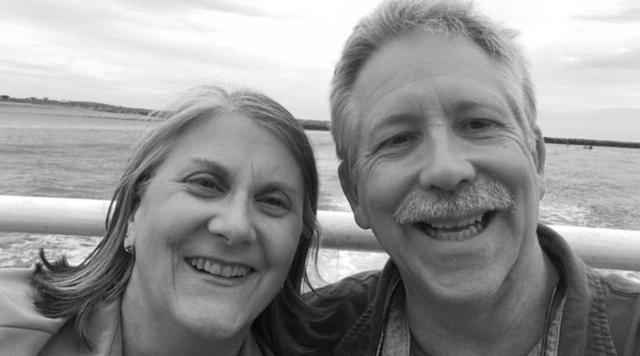
garding resources…” The Osterlohs have developed a shared passion in helping others, which they carry out through their EMT work. They are hoping to explore the possibility of facili tating equipment no longer in use from the New Hampshire fire departments to be shipped to be reuse in their new home. “We would really like to learn about emergency services that are not available in Myanmar, and to see if we might be of assistance. There is equipment in the local departments that’s no longer in use and perhaps it can be utilized in another country.”
Of course, Osterloh will miss her home in New England. “I will miss our fire departments. I will miss my job. I will miss the counselors, and my boss. I love this job so much. The connection with the students and graduation. I will miss graduation and just seeing all the work of the four years.”
Besides her joy for travel and organization, Osterloh has a passion for baking. Osterloh is famous for her cinnamon rolls throughout the counseling department. “I’d be lying if I didn’t say, ‘Oh my gosh! No more cinnamon rolls!’” says ORHS coun selor, Kim Sekera, whose family has developed a relationship with the registrar extraordinaire over the years. Sekera shared that every year during letter of recommendation writing season, Osterloh will bake with Sekera’s children to give their mother the time she needs to write. Osterloh will not have an oven in Myanmar, but she already has a plan. “I’m not hoping, I know,somewhere, I will connect with someone who has an oven that I can either pay them to let me use, or they would be happy to accept an exchange of baked goods for letting me use their oven.
The rehiring process to fill Osterloh’s position has just begun, but, “she has set the bar really high. We will have to scale our expectations back,” says Kim Cassamas, counselor and colleague of aOsterloh at ORHS. Her coworkers describe her as very hardworking, data oriented, friendly, and caring. Director of Counseling, Heather Machanoff, notes, “she is really good at making students feel welcome. She is always willing to help stu dents and not minimize anything that was going on with them.”
When Osterloh leaves home soil once again on July 18th, she will be fulfilling her purpose, living the most meaningful life she can, and satisfying her hunger for exploration. “Sadly, my brother doesn’t get any more [experiences]. And I don’t want to be the person that doesn’t get anymore. I want, regardless of how many more years I live, to have more meaning than just hoping I live.”
 By Grace Castonguay Photos courtey of Sandra Osterloh Artwork by Chloe Jackson
By Grace Castonguay Photos courtey of Sandra Osterloh Artwork by Chloe Jackson
Flashback to October 20th, 2018: My mom called me downstairs in a panic to show me an email from College Board. I started reading out loud, ‘thank you for sending your official SAT score reports through College Board’... WHAT?!!! ‘...Please allow up to THREE WEEKS for your report to deliver’?!? My applications were due November 1st, barely over a week away. I was devastated. I thought the application that I had put months of work into, was down the drain. All I could do was wait patient ly and pray they arrived, and what do you know? They did and I got into my dream school! So I promise you that while the application process was without a doubt the most stressful period of my life, every part of it was worth it. Even if you don’t get into the school you initially have your heart set on, you will end up somewhere even more perfect for you.
I approached the application in phases starting with planning, researching/touring, financing, testing, and finally applying, so this article is broken up accordingly. Tackle one phase at a time to keep a handle on your stress level!
But before beginning, the first thing you should consider is whether you want to attend college, and do you want to for the right reasons? “College is a large investment, of both time and money, and this is something that I think more students need to realize before entering an institution,” says Sam Belanger. Attending a four year college experience or taking a different path are equally great options, however this article is geared for those who choose to apply to college.
I was thankful to have great resources that helped me through the nerve-wracking process, and overhearing juniors’ struggles as they begin the process makes me further realize how lucky I was. I asked a number of seniors what they wish they had known a year ago. For those of you who are lost, overwhelmed, clueless, or all of the above, I hope these tips help you.
Sam Belanger: “With early action you will receive your decisions earlier, which means you have time to add other schools to your list if you don’t get into the one you want (happens to the best of us). Senior year is stressful and getting applications off your plate early will definitely help you to enjoy the ride a little more.”
Liesey Parsons: “I think movies try to portray a ‘typical’ college experience but everyone is different and it’s hard to know what you want without doing any researching.”
Charlie Haskell: applied to thirteen schools and with the even distribution of safety, match, and reach, and assumed she would get into about half and have six or seven to choose from. “I ended up being accepted to a third, waitlisted to a third, and rejected from a third. And that leaves me with less choices than I thought I would have.”

Cam St. Ours: “If you’re planning on apply ing to a specific program, some of them have different deadlines, acceptance rates and require ments than the rest of the school. Make sure to research ahead of time. If you’re applying to a competitive major, have back ups.”
1 2

Create a timeline of when you’ll com plete different parts of your applications. Plan on applying early action so if you can’t meet a deadline, your SAT score doesn’t send, the internet crashes, or any other tragedy strikes, you will still have regular decision to fall back on!
I took notes after every college visit, which gave me the chance to reflect on what aspects of the school I liked, and dis liked. These notes were particu larly helpful in refining my list of schools.
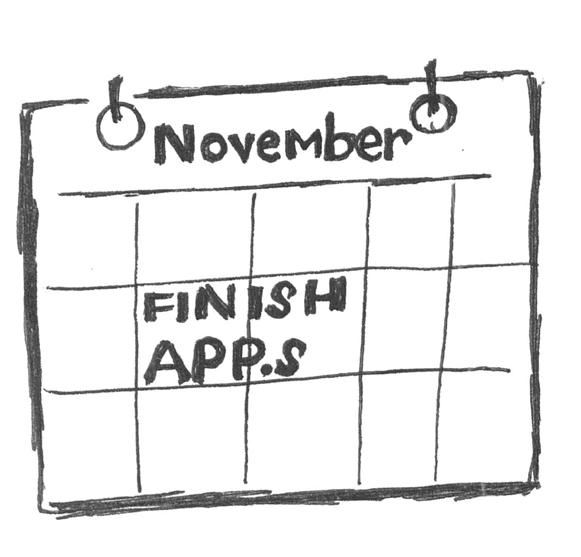
Have the conversation with your parents about whether they will be able to contribute to your schooling, and if they can contribute -- how much?
And ask yourself...
How much debt am I willing to take on?

What might my salary be in fields I am interested in?
Will I be able to pay off my loans? Will this school set me up for financial success?
• The SATs mainly judge your ability to take a test, not your knowledge of the material.
• Know what kind of studying works for you.
• Try your best but don’t stress.
Often people think their essay needs to be about a topic no one has written about before. “Just use your voice in the story to tell it from a new perspective,” says Kantapudi.
• Get a second, and third set of eyes on it. Have a teacher, neighbor, or relative that you know on a less personal level, give feedback on what they take away from this about you because it’s closer to the perspective an admissions coun selor will have.
• Having close friends and family read over your essay is also important. Is it authentic?
• Check for is grammar and spelling.
$$$$$$$
Belanger: made a detailed spreadsheet which broke down scholarships, grants, and federal loans that each college offered. “This helped me to break down exactly how much it would cost me to go to each school I applied to, and how much debt I would graduate with. While I don’t think everyone will want to make a spreadsheet, I certainly do think that it’s important to be or ganized when those financial aid and scholarship packages start coming in.”
Parsons: “Often times underclassman feel like their grades won’t matter in the long run but I have always done pretty well in school and I received merit scholarships that I wouldn’t have otherwise. It is not only tremendously helpful but it’s also rewarding seeing that the hard work paid off.”
Parsons: “It’s easy to dream of the perfect school or going to an Ivy League but many of those schools have to have an SAT cut off score just to cut down the applicant pool.”
Demetrius Phofolos: “Take the time to learn what the SATs will ask and how to eliminate answers, and you’ll do so much better than someone who might be better than you at math and English.”
Parsons: “Know what kind of studying works for you. My mom bought me test books and just looking at the thickness of the book intimidated me so I tried Khan Academy (a free option) and ended up raising my score over 150 points.”
Belanger: “I know that SAT’s are a big source of stress for a lot of students, but I think that stress is unfounded. While colleges do look at your scores, more and more schools are starting to look at your other credentials.”

Rohit Kantipudi: “Don’t be obsessive about them. Once you’re in the range for your school’s 2575th percentile it’s the other parts of the applica tion that really matters.”
Parsons: “Work on the CommonApp a little each day. It is a very long process and it can be discouraging looking at the long application but a lot of the information is personal and quick to fill out. The most important thing is to make your self look well rounded but to pinpoint something unique about yourself.”
Applying to college has become a much more labor intensive process, but being systematic in your approach can ease the stress dramatically. Remind yourself that all of the hard work will be worth it once you start receiving your acceptances. At the beginning of my senior year I was so close to taking a college off my list because it had more application requirements than any of my other schools, but luck ily I didn’t because that is the school I will be attending next fall! If you only take away one thing from this, let it be that just by delegating time and prioritizing this work, you’re already putting yourself in a great position. Trust that no matter what happens, you’ll end up right where you’re supposed to be!
Phoebe Lovejoy Artwork by Phoebe LovejoyWhat do you think of when you think of Durham? Is it the University of New Hampshire? Is it sledding on Wagon Hill? Or the never-ending road construction on Route 108? Up until recently, I may have thought of any of those as well. Now, I as sociate it with a series of stories and people that helped to shape the town.
In the earliest days of Durham, the town was the seasonal home of the Abenaki tribe, who came down from the Northern mountains for hunting and fishing. After the arrival of British colonists, the town’s position on the Oyster River gave it an advantage when it came to exporting goods, primarily lumber, to England. The town separated from Dover upon its charter in 1766 and then became home to the New Hampshire College of Agriculture and the Mechanic Arts, now UNH, in 1893.
While an exhaustive history of the town of Durham would fill in all the blanks, it would also be longer than an issue of Mouth of the River and already exists in the form of the Durham Historic Association Museum. After talking to Nancy Sandberg, the curator of the museum, and Phyllis Heilbronner, a longtime Durham resident, I have composed a collection of some of the best stories from Durham’s history.
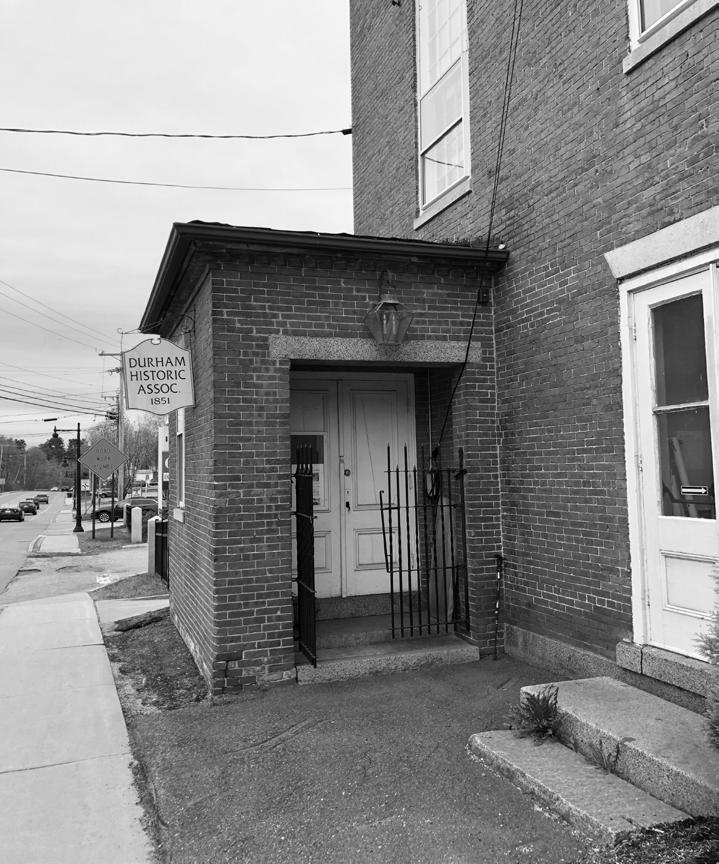
According to Sandberg, the British who came to Durham were adventurers in search of independence. This meant that, “in Oyster River and throughout the Seacoast, there were all these people who were just really incensed by all these limita tions [enforced on the colonies by Britain].”
Before the start of the Revolutionary War, the early peo ple of the Seacoast were ready to act on their frustration with Britain. “They got the word from Paul Revere in 1774, who came up the coast from Boston to let people in Portsmouth know the British were going to be fortifying Fort William and Mary, in Portsmouth,” said Sandberg.
With this knowl edge, a group of Patriots led by John Sullivan took a gunda low down the river to New Castle on the tide to take cannons and the gunpowder. Sandberg said, “they held up the two guards and said, ‘we don’t want to kill you, but to maintain our own safety, we’re
going to remove the gunpowder and two of your cannons.’ And then they came back on the tide.” Sandberg explained that they hid the gunpowder under the meetinghouse and in the Powder Major’s house in Madbury. They stored the gunpowder and the cannons until they were used in the Battle of Bunker Hill.

Sandberg acknowledged that later on, John Sullivan, “did some bad things. He was ordered to go out to western New York state and kill all the Iroquois Indians out there and burned all their corn and houses. It was horrible what happened, but he was ordered to do it and he was one of Washington’s very good soldiers.”
After the events at Fort William and Mary, John Sullivan went on to serve as a general in the Continental Army. Because of his service to the United States, Sandberg considered General Sullivan to be Durham’s hero.
The New Hampshire College of Agriculture and the Me chanic Arts moved here from Hanover, New Hampshire, in 1893. In 1923 the state legislature changed the name to the University of New Hampshire, according to a brief history of the univer sity from its website. Sandberg said the move, “was a big change for Durham, having the University come to town. It was a small impact at first, maybe only a few hundred students, but it grows exponentially.”
In 1919 the school had 607 enrolled students, after the GI Bill following World War II, the population of the school had increased 30-fold since 1900.
Sandberg said, “I think the residents of Durham had kind of a small town feel, and when the college came, the faculty inte grated into the town easily. They really became a close knit part of the community; faculty started taking part in our town gov ernment. One of the wives was very instrumental in restarting the Durham Historic Association.”
Phyllis Heilbronner moved to Durham with her husband, a UNH professor, in 1954 and got a job on campus working for the Protestant Minister. She has lived in Durham ever since. Heilbronner loved Durham for its small town feel and described the same welcoming environment that Sandberg depicted. Heilbronner said, “having been a refuge from Nazi Germany,
The New Hampshire College of Agriculture and the Mechanic Arts
[Durham] felt very secure to my husband. He just felt really comfortable, very happy here.”
Sandberg noted that the change on campus has brought change to the town as well. “Now it’s different because not so many of the University faculty can live in Durham; they come from away, a lot of commuting takes place.” Heilbronner also addressed this, saying, “many of the faculty do not live in Durham because of the high taxes, and I think that the fact that such a huge portion of our taxation goes to the support of the schools.” However, Heilbronner believes that Durham has retained its small town charm.
Another hero of Durham was Richard H. O’Kane, who served on the U.S.S. Tang, among other submarines. Sandberg said, “he was an unbelievably brave submarine commander during World War II, and he wrote this book about fighting in the Pacific, Clear the Bridge.”
Sandberg explained that O’Kane, “mastered fighting with a submarine, lying in wait for Japanese ships to go over head. He knew how to maneuver the submarine to get into position to send the torpedos to take the ship out.”
While he was on the USS Tang, Sandberg said his subma rine, “was sunk by the Japanese, and he and his men were picked up by the Japanese and put into a prisoner of war camp, and the story of how they survived it was unbelievable. His wife was here in Durham with their two young children, waiting, worried. She knew he was a prisoner of war, and she didn’t know whether he’d make it home or not. He did make it home, but he was down to like a hundred and six pounds. It was grueling, horrible, horrible story.”
Sandberg continued to explain his actions during WWII. “On his other submarine assignment, he picked up all these air men. Their plane was down and put them on his submarine and brought them back, fished them right out of the sea.”
Sandberg explained that O’Kane’s ties to Durham traced back to his childhood. “He was a local kid who grew up in Durham and he was smart as a whip. And he probably got into lots of trouble because he was smart and he liked to hang out around the bay and sail and boat and stuff like that.”

O’Kane represented Durham and the country overseas well
according to Sandberg, and he was the perfect person to do so. “He grew up in Durham so he was this all-American boy.”
For the most part, in my conversation with Heilbronner, she described a quaint, comfortable, New England town, that had changed little beyond growing with UNH. “I don’t think the town was as politically active in the early days as it is today. I think [the younger] generation is far more involved the political life of today, which certainly impacts our lives, I think a great deal more,” she said. However, she had a vague recollection of an event at UNH which had brought the students to protest during the height of Cold War communist tensions in the U.S. surrounding Professor Gwynne Daggett.
Daggett was an English professor with a well known penchant for teaching all perspectives, regardless of political no toriety of the beliefs. Daggett was also accused of encouraging students to participate in acts of “illegal acts of civil disobedi ence” when it came to expressing their beliefs.
During the 1940s, this made Daggett a target of Manchester Union Leader and New Hampshire Sunday News publisher, Wil liam Loeb, who wrote a series of editorials attacking all those he viewed as “dangerous or subversive,” according to an article, “Courage Under Fire”, from the Fall of 2001 issue of UNH Magazine.
The article said, “at a time when government sought an obe dient citizenry to cope with both real and imagined threats, Dag gett urged students to think for themselves.” Daggett seemed to startle a stagnant town with his idealism and the strength of his conviction in freedom of speech.
Even when Durham was in the limelight and the university with which Durham is so closely tied was under attack, Heilbron ner presented the town as a happy place. She said, “the Eisenhower years were very secure. They were happy years for most of us; we were growing families. Politics was not seen in such a negative, divisive way that it is seen today. I mean what we’re living through today is even beyond what the Nixon years were like, or the Clinton impeach ment.”
Durham didn’t magically remain the small town that Hei lbronner talked about, there were those who fought to keep it that way. In March of 1974, Durham rejected a proposal for the construction of what would have the been the world’s largest oil refinery. On the 40th anniversary of this rejection, in 2014, the Durham Historic Association (DHA) Director Dick Lord recog nized those people who, “fought the refinery proposal to protect the small town character of Durham,” according to an article on the town website.
As of the 2010 census, Durham had 14,638 residents, and UNH has grown to over 13,000 undergraduates. Yet, in the end, Heilbronner had it right in that Durham, “just had a wonderful small town feeling to it and it made it very pleasant to live in.”

Taking a closer look at Oyster River High School’s online administration of the SAT
Junior year is infamous for its heavy workload, difficult classes, and college preparatory work. Perhaps the most ominous task of this busy time lies within taking the SAT, which was administered online for the first time this spring.
The change came shortly after the SAT’s score range, length, and number of questions were completely remodelled in the spring of 2016. Although these factors remained the same in this year’s online test, many students had varying opinions on the switch, as well as on what it could mean for the future of standardized testing.
“Everything is moving in a technology-centric direction nowa days, and it is much easier for tests to be processed digitally rather than on paper. Online tests provide quicker, more concise grading, and I think that it only made sense that the major country-wide tests would look to utilize that,” said Megan Deane (‘21), who will take the test next year.

The Oyster River school district is no stranger to online testing, with the STAR, NECAP, and Smarter Balance tests already being administered online. The SAT, which ORHS uses to fulfil New Hampshire’s summative assessment re quirement, first joined these online tests in 2018, but was not utilized locally until this year.
Despite the fact that the online SAT was available to all schools nationwide, Oyster River joined a select few districts in New Hamp shire who chose to administer the digital version in 2019. Celeste Best, a science teacher at ORHS who also provided technolo gy support during the SAT, thought that this might have to do with the district’s avail able technology. “Even though all schools had the opportu -nity to switch, not all of them have the laptop capacity. We’re lucky to be going one-to-one at the high school within the coming years, which gives the district the ability to administer a large-scale online test,” she said.
Although going digital promises quicker score returns, cheat ing prevention measures, and more uniform testing environments, some students were wary of the transition. “The online test felt a lot different than what I’ve done in the past. I think it was more of a hassle trying to use scrap paper for the math sections instead of just being able to write on the problem. I’ve also never been a fan of reading online, so I was not thrilled to have to read the passag es for that section of the test on a computer screen,” said Chloe Jackson (‘20).
Jackson’s thoughts were mirrored by Noah Hall (‘20). “I wish I had known all of the options that we could use during the test, like ‘strikethrough’ and ‘highlight’ beforehand,” he said.
Both Jackson and Hall plan to take the SAT again, but will seek out locations that still offer paper-based testing. “I had already planned on taking the SATs more than once, but now I feel even more encouraged to just to see if the online testing had any affect on my scores,” said Jackson.
However, when, or if, students choose to take the test again, it will be the first time they have to come up with the time or registration funds. The district currently covers the costs of both the PSATs and the SATs, as well as allotting a specific school day that is solely dedicated to standardized testing.
Others still felt as if online administration added a whole new element to the already-stressful process of standardized testing. “In general, I think people emphasize the SAT so much because it’s something that’s hammered into our ideas of the college acceptance process,” said Anna Haight (‘19). “We think that good schools are equivalent to selective schools, and that the only way to get into these ‘good’ schools are with impressive SAT scores. I can see how people would be nervous about the change [to online test ing].”
Another difficulty en countered in the transition to online testing was learn ing how to use the software. To combat this, all junior advisories were required to use a Flex block to give students and teachers alike time to familiarize themselves with the testing
“I feel that there were less things for people to be worrying about [online],” said ORHS science teach James Thibault, who proctored the test in March. “When students did the pre-administration session that was given during Flex, they were forced to get onto the website and input the codes they would need on test day, and that exposure then helped [the students] get used to it.”
However, many students felt this time was ineffective. “I didn’t think the Flex period prep was beneficial at all. Half the time my advisor was trying to figure out how to administer it to us, and when we got to the practice test, most kids just clicked random answers to finish it and then start doing whatever else they wanted to do in their Flex time,” explained Jackson.
Hall had a similar experience. “I didn’t worry about the test while taking it, but I do wish that we had more practice with the software before we took the test. As time went on, I got better with the software but the start was rough, because I didn’t know I could visually eliminate answers for the first couple questions,” he said.
However, when it came time to take the test itself, some people preferred the online version.
“From what I heard through my advisees and others, many
[students] actually preferred the online version,” said Best. “There was huge stress before [the test], but once we worked through it and students got familiar with the software, it seemed like many people were confident with their performance.”
Kaila Lambiasi (‘20) was one of the students who preferred the online version. “I kind of liked the online SAT. [Most students] thought it was going to be terrible because half of the school was going to be logging in at the same time on the same day, but it ac tually went pretty well,” she said, adding, “it was a lot better than having two booklets explained to you even though you already knew what to do.”
Lambiasi’s thoughts reflect the fact that the online SAT did not allow students to move between sections until instructed, as well as eliminating the chance for students to incorrectly fill in bubbles on the multiple choice questions. Subsequently, this meant that SAT proctors did not have to instruct students on these elements of the online SAT as they previously did on the paper version.
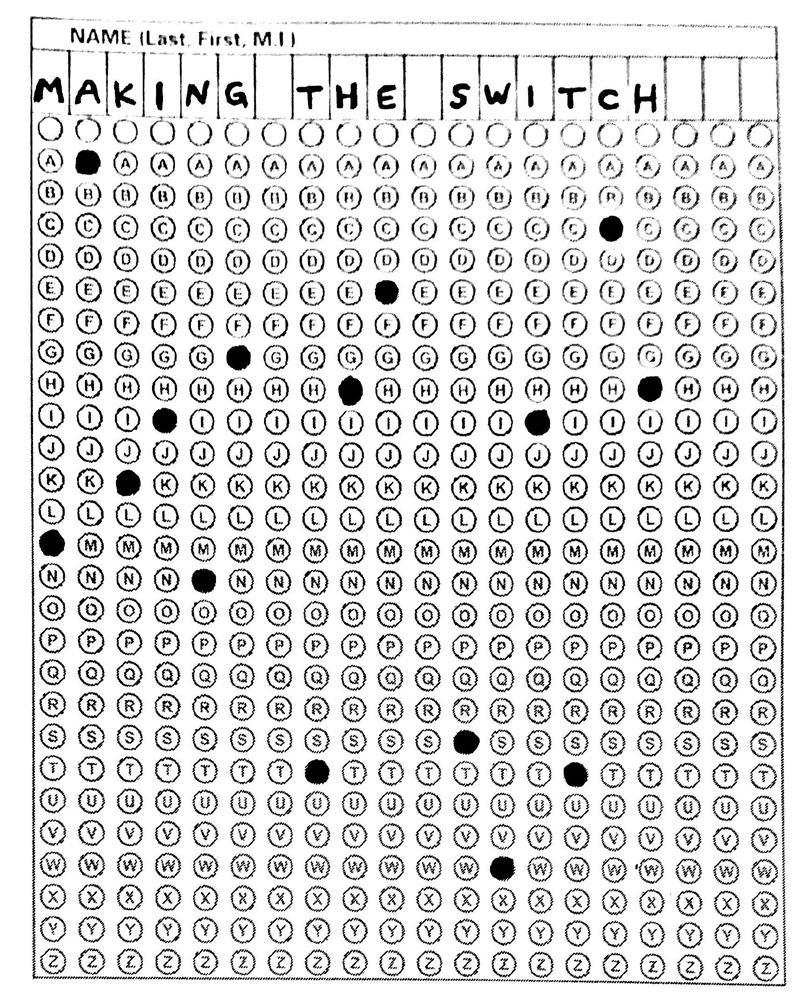
Most notably, the online SAT gave students the chance to type the essay portion of the test, which is traditionally optional but is required by Oyster River to meet the state’s mandate of testing writing and language skills.
Rachel Smith (‘19), who only took the paper version in years past, wishes she could have experienced this element. “On line testing sounds like it would have been better for me because my handwriting is really hard for others to read, so typing allows for essays to be done quicker and more thoroughly,” she said.
In addition to allowing for the SAT essay to be written more quickly, the abil ity to type removes any biases or issues that might arise from having to decipher messy or illegible handwriting. Smith is excited for those who have the oppor tunity to take the online SAT for this very reason, saying, “I remember being stressed that I wouldn’t get a high score since I write in cursive that’s hard to read. Typing would have al leviated that and should help others in my situation in the future.”
Deane, who took the PSATs on paper this year, is not only looking forward to the online essay, but also to the abundance of easy-to-access preparatory materials. “I definitely plan on studying and looking for materials geared towards the online test. I know that I’ll feel much better taking the test if I have a sense for how it will work and what will be on it, and there are a lot of resources aimed for the online version that provide that,” she said.
Some juniors wish that they had also been given this advan tage. “I wasn’t aware that [the SATs] would be online until a few weeks before the test, and it threw me off guard a little. After taking the PSATs twice on paper, I feel like they should be keep ing SAT administration consistent with what we’ve been practic ing,” said Jackson.
Hall agreed, saying, “I took the evening SAT prep class adver tised by the high school and the instructor was unaware that we were taking it online at the beginning. She then tried to gear the class towards the online SAT, but didn’t know anything about it and just kept teaching us as if we were taking it on paper.”
Although, Haight is confident that administering the SAT on
line will make preparation more straightforward. “The SAT prep course that I took sent me a package with paper test booklets and answer sheets that used questions from previous years. After taking these practice tests, I would have to grade them myself using the prep course’s website. Switching to an online version will certainly make grading SAT practice much easier. I think that there will just be an adjustment period where these sites will have to readjust to the online version of the SAT instead of the paper version that has been used for so long.”
The switch to an online SAT also gives many students an ad vantage for preparing in terms of cost. If families do not want, or have the means, to pay for SAT prep classes, many online resourc es are free, such as the notable practice site Khan Academy.
In the future, some are confident that the paper version of the SAT will disappear entirely. “Surely, they’re going to transition it so that the paper SAT isn’t an option anymore just because of the quicker time [of score returns], and I don’t see why anyone would really be complaining because of how much paper that saves,” said Lambiasi.
Best agreed with Lambiasi’s thoughts, and is confident more changes are to fol low. “It’s the 21st century, and I’m honest ly surprised [the switch to online] hadn’t happened yet. It’s a matter of changing mindset along with the technology, so it was bound to take time, but I could easily see the online version becoming standard within the next three or four years,” she said.
For now, the College Board has not re leased any statement about the future of switching to online testing. According to “Here’s What You Need to Know About Online Testing for the ACT and SAT” from The New York Times, the College Board’s primary concern was with the security and strength of the servers used to administer the SAT. To troubleshoot this, the company opted to use a browser that allowed schools to see how many computers could be supported before the test was even adminis tered, as well as ensuring privacy software was installed.
With this year’s change, many students were confident that the SATs were only the first of many paper-based tests to make the transition. “I can see other tests following the online format of the SAT if it’s seen as a success. I can especially see the APs doing this since they are run by the College Board just like the SAT is. I think it mostly depends on the results from this SAT and the general consensus from those who took it if it’s a positive or negative thing,” said Haight. “But whatever happens, just remember that even though lot of people think that your SAT score is a direct reflection of your overall intelligence as a human being, that really isn’t the case.”
Looking to the future, Best is confident that the success of the online SAT, not unlike the paper SAT, will lie in preparation. “It’s going to be all about communication. It’s super important for both proctors and students to continue to walk through the tech nology to alleviate stress on both ends, which will make future tests go more smoothly.”
- Devan McClain Artwork by Liev ManckIt’s 3:05. A group of Oyster River High School students race out of school together, hop into a car, and drive into downtown Durham with grumbling stomachs. They park and stroll across the parking lot dreaming of Lexie’s Chocolate Oreo milkshakes they have been craving all day. The group approaches the entrance of Lexie’s Restaurant and they see a “permanently closed” sign displayed in the window. Every student looks at one another, confused. The night prior, they waited for a dinner table for nearly 45 minutes.
Downtown Durham is home to a variety of small businesses that many people in the Oyster River Cooperative School District (ORCSD) regularly shop and eat at. Even with locals and students from the university populating the area and keeping some of these businesses open, many still struggle to survive. This prompts the question: why?
Solsistar Boutique is one of the local businesses owned by Laura Rothstein. She spoke about why a number of businesses have had a difficult time staying open, saying, “there are quite a few factors contributing to businesses not being able to make it. A major one is that the rents are incredibly high, comparably.” She continued, saying, “also, parking is a huge factor in this town and if people can’t park, they aren’t even going to bother.”
Alongside Rothstein, Justin Petrovitsis is an owner of both Durham House of Pizza and JP’s Grill. “Durham is a difficult town to do business in. With the university, it’s very seasonal. Six months of the whole year it’s busy, while the rest is less busy.” He added, “a lot of people go into opening a business thinking it’s going to be crazy year-round, when really, it’s slower during the summer time and during breaks.”
Susie McDonogh (‘17), a current UNH student, also explained why small businesses have had a difficult time staying open. “A lot of UNH kids don’t have a lot of money to spend and a lot of the businesses don’t have enough people in town that are interested in what they serve.”
These complications have affected a number of businesses, from restaurants to boutiques, in Durham within the past
decade. Alongside this, the high tax rates and high rental costs of the complexes in downtown are not helping the situation.
According to the New Hampshire Department of Revenue Administration Completed Public Tax Rates from 2017, all of the towns and cities in the state have total tax rates that range from $6.00 to $37.00. Durham is on the higher end of the spectrum with a total tax rate of $30.64.
One of the businesses that struggled because of these high numbers includes Lexie’s Restaurant, which was found at 10 Jenkins Court. An employee at the Portsmouth Lexie’s Joint, Megan, noted, “I am not sure on the specifics of the numbers but I know the Lexie’s in Durham could not stay open because I know the taxes and the rents were very high.”
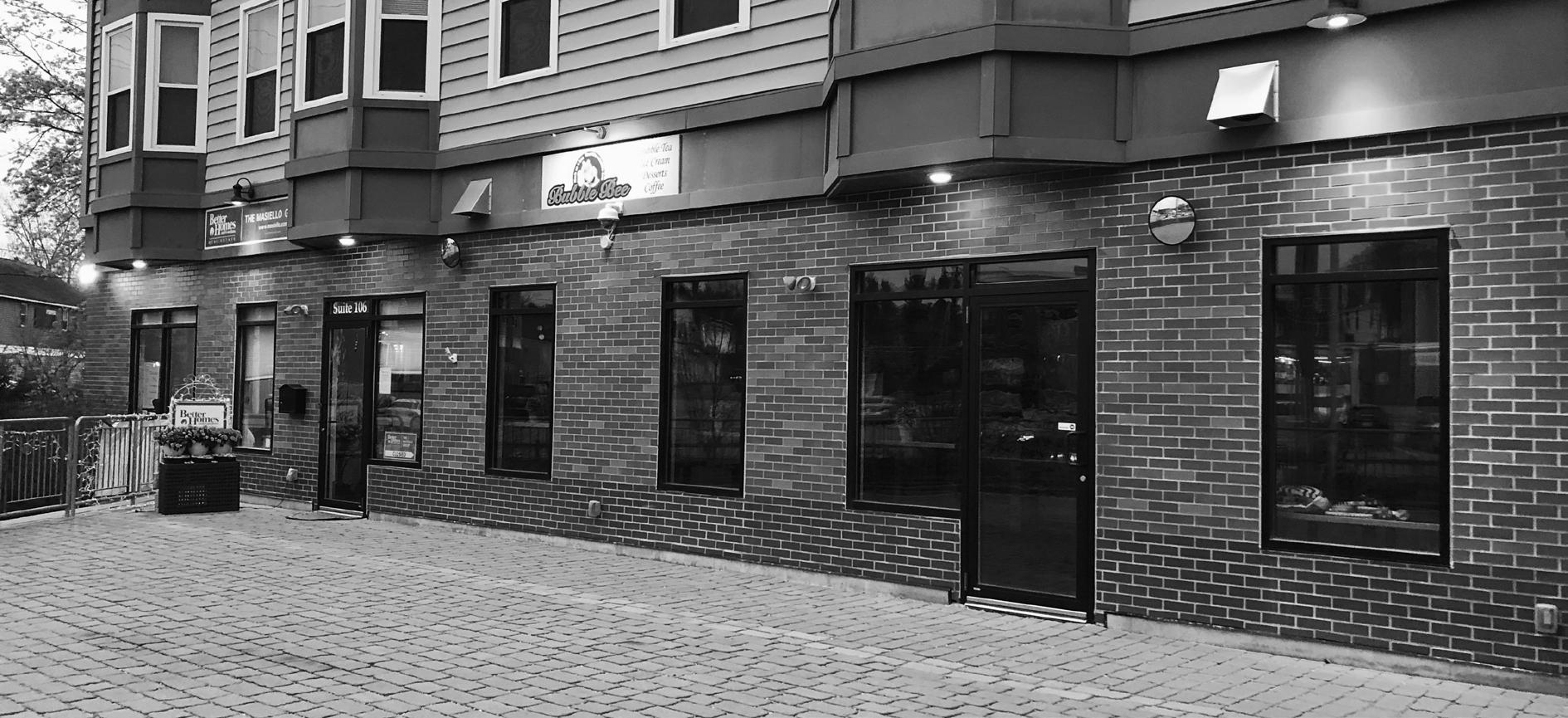
Anna Haight (‘19), who enjoys getting food in downtown Durham in her free periods with her friends, noted, “I was super sad to see Lexie’s close since I loved their food and had a lot of good memories there.”
Alongside this, the complex on the first floor of a UNH apartment building located at 9 Madbury Road has had numerous businesses come and go within the past decade. Two frozen yogurt shops, being FroZone and then FroyoWorld, did not stay in business for long. In addition to these was Nomad’s Kitchen.
Laurel Gordon (‘19) was an employee at Nomad’s Kitchen when it was still open in Durham. After about six months, Gordon was asked to seek other employment options as the restaurant was permanently closing. She spoke about Nomad’s Kitchen, saying, “the restaurant did fairly well when I was working, but the owners rarely came to see how we were doing to check in.” She continued, saying, “to me, it felt like it was run okay, but I had a feeling that they were not going to stay there long.”
Similarly, the location on the main strip of Durham where JP’s Grill is has had a number of restaurants come and go within the past decade. These restaurants include JP’s Eatery, Mama Mac & More, and Taco Mano. The Petrovitsis family
bought this building and originally started businesses in this complex, being Durham House of Pizza (DHOP) and JP’s Eatery. Durham House of Pizza has been doing well ever since it opened. Petrovitsis noted, “DHOP has been in business for 46 years now. My parents started the business and I was really young at the time. After my parents decided to retire, I decided to take the business over.”
Once Petrovitsis’ parents retired from the business, he decided to continue to own Durham House of Pizza, but opted to sell the other half of the complex. This business ended up becoming Mama Mac & More and then Taco Mano. As Durham House of Pizza is located directly next to the complex where these two restaurants were found, Petrovitsis noticed that these businesses did not focus on both the locals and the college students. Both businesses struggled and both ended up closing.
Despite this, Petrovitsis spoke about the how his businesses have been successful. “Over the years, as a business, we have learned to focus on the town residents and the college students. By focusing on both, it makes everyone happy, which is the desired goal,” he said.
Because of his knowledge of how to properly run a business in Durham, Petrovitsis highlighted that as soon as Taco Mano left, he, along with his Durham House of Pizza colleagues, took advantage of the opportunity to open another business. He noted, “JP’s Grill has been successful ever since the opening.”
Oliver Cinq-Mars (‘19) is one of the employees at JP’s Grill and spoke highly of his experiences working at the restaurant. “It’s always pretty busy, especially for a recently opened restaurant. It’s mostly busy on Saturdays and Sundays, but it still gets quite a bit of business on the weekdays,” said Cinq-Mars.
In addition to JP’s Grill, Solsistar Boutique, which is a clothing store next to Hair Excitement, has been successful for the seven years it has been in existence. Rothstein stated, “there will definitely be slower months than others. But, I think we have done okay because we don’t strictly cater to only the college students.”
Even despite their success, Solsistar still relocated in town due to high rental costs. The previous location of Solsistar was in the building at 9 Madbury Rd. Now, the business is found on Main Street.


Similarly to Solsistar Boutique, The Spot, which is an acai restaurant, moved locations in Durham because of high rental costs. Their previous location was in the same building where Lexie’s Restaurant was found. Now, the business is located in a smaller venue at 13 Jenkins Court. Although, McDonough noted that this business is very popular among UNH students.

In summary, Haight spoke about how it is unfortunate that several businesses closed. “With only the same few restaurants staying open in downtown, it makes it hard to try new places. Durham is so small and I wish we had more options of places to eat and shop.” She continued, saying, “the fact that most new businesses don’t last long makes it hard to find things to do locally, and a lot of times, I go to other towns instead because of that,” said Haight.
Despite this and the difficulties with costs, numerous businesses are still attempting to fill the vacant complexes in downtown. Denise Sassmann, licensed Associate Broker for New Hampshire and Maine and member of the National Association of Realtors, said, “there is now a new place going in where Nomad’s Kitchen was located called Bumble Bee. It’s going to be a bubble tea place.”
Although Durham has proven to be a difficult town to own a business, Petrovitsis said, “it’s important to remember that Durham is a college town. We have learned that it’s advantageous to focus on both the town and the college students in order to be successful.”
In her first year in the Oyster River Cooperative School District, Andrea von Oeyen had her work cut out for her. Assigned to be the district’s String Orchestra Director, von Oeyen was responsible for designing, implementing, directing, and growing the Oyster River String Orchestra at both the high school and the middle school.
Five years later, nearly 220 students filled the gymnasium at Oyster River High School, holding violins, violas, cellos, and basses. After a year’s worth of hard work, students playing a stringed instrument from grades 5-12 gathered together to perform one last piece. This year’s district concert, held on May 8th, triumphantly con cluded the program’s fifth year in the Oyster River Cooperative School District.
Since the program’s creation in 2014, the Oyster River String Orchestra at both the high school and the middle school has grown in popularity, size, and programing. The orchestra, although having faced some obstacles, continues to evolve at both the middle school and the high school.
Now at that the orchestra has hit its five year mark, von Oeyen is looking to implement more opportunities for stu dents to engage with their instruments in new and thought-provoking ways. Collaborations with the band program at Oyster River and the University of New Hampshire as well as trips to create a cross-cultural and musical experi ence will occur in the following years. With the possibility of a new middle school for the ORCSD coming soon, the orchestra program is optimistic that certain issues such as storage and rehearsal space will become problems of the past.


Although the string program in the district officially began in 2014, a small group by the name of OREO, Oyster River Elementary Orchestra, laid the foundation for a suc cessful orchestra future at Oyster River. The program was taught by current ORMS Band Director, Sarah Kuhn. Be ginning in January of 2012, practices were held once a week after school for about an hour and a half, and the program was open to students through 6th grade enrolled in private lessons.
When I came to the ORCSD in 5th grade, I was hopeful that I could continue to play the cello. Because I was the only one in that section, I was given the trombone part to play on the cello. I found it very difficult and challenging to grow as a cellist in 5th grade when no one else was playing my instrument. Kuhn adds, “my hope was that parents would see how inequitable that was as compared to the band experi ence.”
The creation of the Oyster River String Orchestra came after a group of interested parents addressed the issue to the school board. One of these parents was Brian Turnbull, who wanted to see an orchestra program in the district. In another interview conducted in 2017, Turnbull explained that he was surprised that Oyster River was lacking a music program offering band, chorus, and orchestra continuing through to the high school level, considering the resources that were made available from the University of New Hamp shire, right up the street from ORMS and ORHS.
“Adding orchestra to the existing band and chorus offer ings seemed a no-brainer — a logical step — and, given the success and popularity of OREO, I felt the time was right to ask the schools and community to support taking things to the next level,” says Turnbull.
What was once a conversation among few has become a large part of the culture of the Oyster River Music Depart ment. With so much growth occurring in the last five years, many are interested about how the program will be develop ing in the next five years.

In the school district, all middle school students are re quired to participate in a performing ensemble: band, string orchestra, or chorus. On the alternating Blue/White day, the students will have von Oeyen every other day. At the high school, music is optional, with band and orchestra occurring during E-period on Blue and White days. As String Orchestra Director, von Oeyen travels to the high school to teach two out of three days, forcing her to account for travel time.
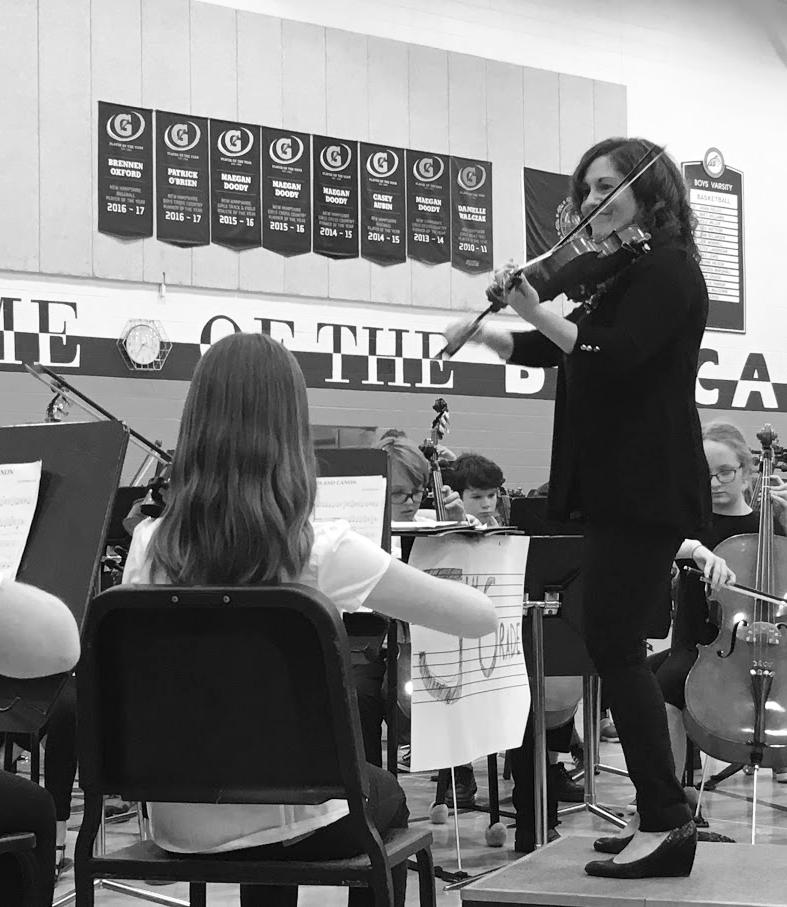
In its fifth year, von Oeyen is very impressed with the orchestra. “The growth of the high school program has been wonderful and the level of music we can play due to that growth and increase in skills has been far faster than I could have imagined. It’s extremely humbling and exciting!” stated von Oeyen.
One very exciting aspect that has grown in the past five years has been the development of the bass program. Von Oeyen said, “I have tried to add an increase in our double bass section in the past couple years. It’s hard because we don’t always have the staffing to make that happen, but it’s very important in our ensembles, so I’m making an effort to do that. We have three bass players in the 5th grade orchestra, so I’m excited about that.”
Emily Schuman (‘20) has been a part of the orchestra for the past three years as a cellist and said that the biggest dif ference she has noticed is the size of the group. “[The growth is] very evident in the cello section specifically. My freshman year, there were four of us and this year there are 11. That is obviously a huge difference in both the sound and social dy namic of the orchestra.” Schuman concluded, “we have a lot of freshman that join every year, so we just keep growing.”
One of the biggest challenges that the orchestra has faced both at the middle school and the high school has been space. “Storage and space are always challenges in music programs. Because both of our buildings weren’t built when the orches tra program was around, there is no designated space for it in either school.” She explained that storage at the middle school is in the cafeteria and locker rooms and teaching occurs in the cafeteria, MPR, and auditorium. “It’s challenging to not have a designated teaching space because there’s not only a lot of equipment to house, but there’s also a lot of time devoted to set up and take down of chairs and stands.” Additionally, tem perature of the storage space can act as another problem since “instruments can be thrown out of whack due to even slight temperature changes.”
The impact that von Oeyen has had is evident in how fondly her students speak of her. “She’s so supportive and she always can diagnose a problem, and that’s really helped me grow as a player. I’m very glad I joined the orchestra,” said Carly Hoag (‘19), who started playing the viola in 8th grade. She explained that when she first began, Hoag was the only violist in her music class and when she came to high school, she was one of three violists. Now, the viola section has grown to be more than 12 players.
In addition to the increase in size that Hoag has noticed, she has also seen how much she has grown as a player in the last five years. Notably, Hoag was accepted into the New Hampshire All State Orchestra this past spring and had the opportunity to
“The music we played was far more challenging than any thing I’ve ever done before,” said Hoag, adding. “I was around people who have been involved with, not only music for a very long time and come from very musical families, but have been playing that one instrument for almost their entire lives.” For more information about All State, check out a video made by Alana Ervin at our website at mor.news.
For the middle school, von Oeyen hopes to continue im proving the way the program teaches technique as well as improving music reading ability in Grade 5. “I am also hoping to improve assessments to even further reflect the competencies that we grade on so that students have a transparent idea of what they excel at and what they need to work on.” She added that specifically for the ORMS chamber orchestra, the hope is to continue to attend the Great East Festival, a middle school competition where usic ensembles can perform for comments from judges, as well as other festivals as a reward for coming to extra rehearsals.

In regard to the high school’s program, von Oeyen is focused on, “continuing to increase the level of music that we perform and to increase numbers if possible. If numbers continue to grow, the group may need to be split into two sections and possibly leveled or auditioned.”
Von Oeyen added that another goal will include a trip to London and Scotland next May as well as other traveling opportunities
join musicians from across the state for a weekend of rehearsal and performances.in future years. “I’m really looking forward to incorporating travel into the curriculum at the high school level. These types of trips can be so meaningful and help us to think outside of our world and ‘bubble’ and really make extraordinary connec tions with other cultures through music.” She added, “whether [they are] competitive in nature or not, playing will always be involved in these trips.”
The trip that will be occurring next spring will be in collab oration with the University of New Hampshire as well as their Youth Symphony Orchestra and will focus on exploring the culture and music of a different part of the world. More details will be shared as the groups begin their preparations. Hoag stated, “it was really cool to hear Mrs. von Oeyen say that she was planning on doing this trip after 10 years, but we’ve made so much rogress after five that she’s like, ‘we’re ready,’ so that’s really great.”
Other goals include collaborating as much as possible with the band. “I would like to explore the possibility of doing some symphony orchestra pieces with select wind/brass/percussion players as this is a genre we haven’t explored yet. This would give our classical wind players a chance to play orchestra music which is an experience that many igh school musicians don’t get.”
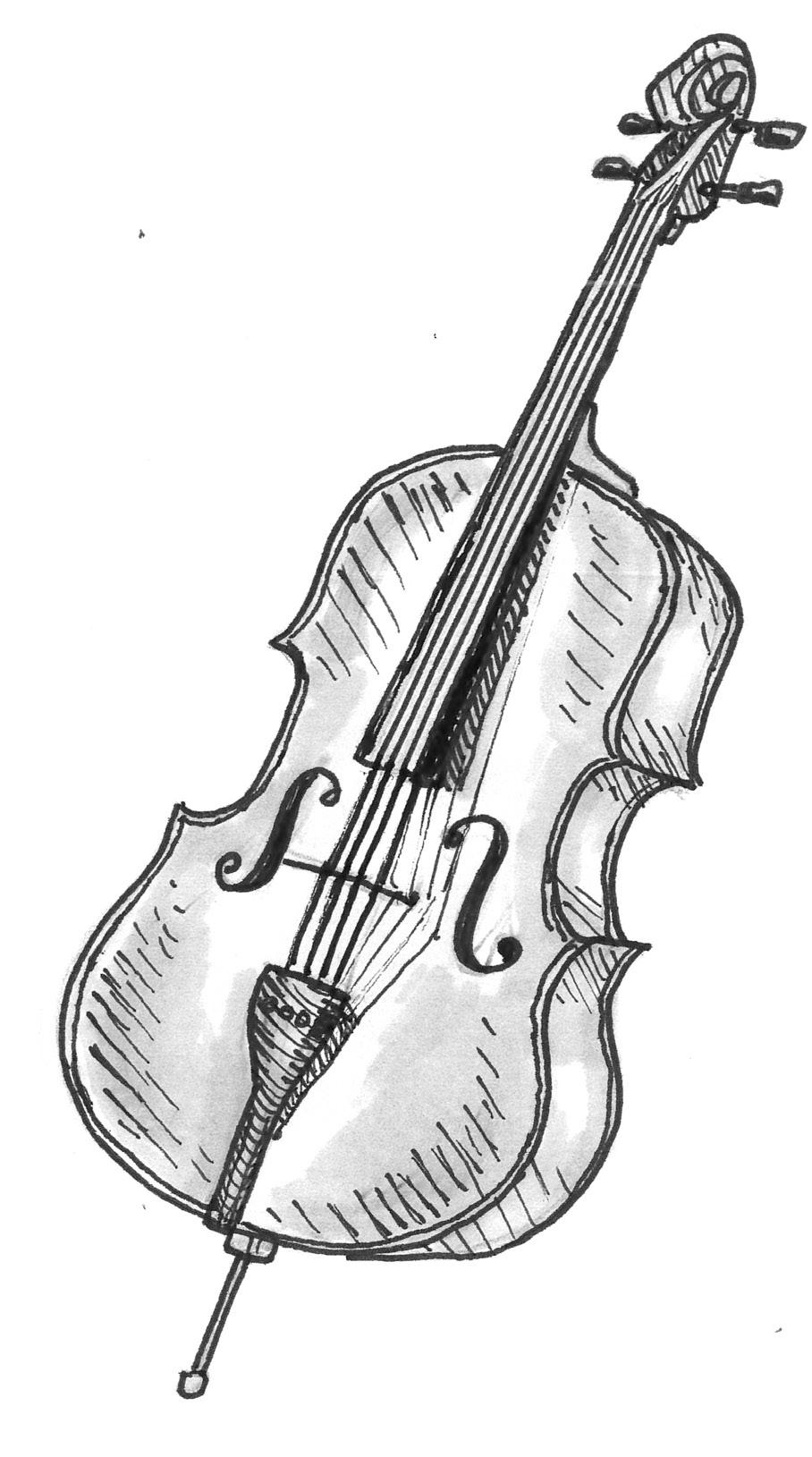
In addition to the potential opportunities that may pres ent themselves in the future, von Oeyen is excited about the students’ growth. “I am also looking forward to seeing more students learn to love music and play at a high level. It’s a joy to watch this occur!” she said.
Looking to the next five years, von Oeyen states, “I hope to remember all of my students that have gone through the pro gram and to continue to enjoy watching students grow from
Andrea von Oeyen graduated with a dual Bachelor of Music degree in Music Education and Violin Performance from the University of New Hampshire in 2005 and completed her Mas ters of Music in Orchestral Conducting at UNH in 2018. She worked in the Alton School District for eight years as a music teacher and began a string program and taught band and general music. Other credits include guest conducting the NHMEA District Festival String Orchestra and the ASTA Strings Fest festival.
when they are 10 to when they’re 18 years old. It’s one of the most special parts of my job. Also, if facilities are improved and changed, I hope to never take that for granted in the future and always remember where the program came from at its youngest stages.”
In light of the program’s success, von Oeyen gives thanks to many for their support. “First and foremost, my colleagues in the string department (Louise Kandle and Autumn Riley): they are my rock! They are always here to help with whatever I need at a moment’s notice and are there for our students. We are all so different yet we work very well together! I also want to thank my music colleagues (David Ervin, Marc LaForce, Sarah Kuhn, Pam Felber, and Beth Struthers) for accepting me into their world and being so supportive of the program. I also am very thankful for the administration who are constantly supporting the pro gram and the parents who pay for lessons, rentals, and drive stu dents to and from those lessons and our rehearsals. I have so much support from all of these people!
As a cellist in the orchestra, I have known von Oeyen for all five years that she has been a part of the ORCSD and have learned so much from her. She is truly a kind, gifted, and passionate teacher who is dedicated to taking this program to new levels. The effort that she has put into this program in the last five years has paid off and I am honored to have played a small role in the success of the orchestra. I am so excited to see the countless opportunities that will present themselves to the future instrumentalists and the role that music will play in their lives. I truly believe that the Oyster River String Orchestra shapes participants to be better listeners, learners, musicians, and individuals.

This school year, many Oyster River seniors began the long, stressful journey through the college admissions process. For some, this meant writing, rewriting, and re-rewriting college essays, taking the SAT one last time, or sending in last-minute scholarship applications.
But if you’ve been keeping up with the news, you know that not too far away, some students began the same process with a different strategy, one that far outweighs the power of a heart-wrenching essay or perfect GPA...
Okay, I know what you might be thinking. Next fall, I’ll be attending Yale University, one of the many schools involved in the admissions scandal. This might seem like a rather odd story to write as someone who is absolutely thrilled to be going to college next fall. However, now that I’ve been given the opportunity to spend four years at one of the most prestigious universities in the U.S., I feel obligated to talk more about the things I’m not so thrilled about concerning the admissions process. More importantly, this scandal opens the doors to a necessary conversation about corruption, privilege, and wealth that I believe everyone, especially students attending these institutions, should be a part of.
Privilege in college admissions is something that impacts every applicant, not just those living in extreme wealth or poverty. The reality is, students don’t have as much control in the admissions process as they might think. Of course, there are countless examples of times when relentless hard work and merit landed a student in their dream school. That said, a brief skim through college news will show you that integrity isn’t the only defining feature in admissions. After spending the past year engulfed in a whirlwind of applications and preparation for college, the admissions scandal didn’t surprise me at all. Instead, the controversy looked to me like just one more glaring reason why college admissions need to change.
In March, 2019, media and news outlets erupted with stories describing various cheating scandals involving at least eight elite U.S. universities. According to “Here’s what universities are saying about the alleged college admissions cheating scandal” by CNN, over fifty wealthy and influential people were involved in the scandal, which included bribes to cheat on tests and admit students as athletic recruits. Various celebrities are facing possible jail time for their involvement in this scandal.
“I’m glad that people are being prosecuted for this, because it’s not fair for rich people to be able to do whatever they want,” said Laurel Gordon (‘19), who will be attending the University of New Hampshire after taking a gap year. “It’s rich privilege,” Grace Henry (‘19) agreed. In regards to Lori Loughlin’s daughter, who was unfairly admitted to the University of Southern California, Henry stated, “I think that she knew [about what her mom did], but she’s putting on an act. I think that she should be kicked out and have to reapply.”
Maddy Alphonse (‘19) agreed that these actions were com pletely unacceptable, especially for people who are already in a position of power. “Rich people are already at such an advan tage for getting into college. They have so many assets at their disposal, yet they still feel the need to bribe their way in; it’s disgusting,” she said.
Alphonse’s point about the inherent privilege that some students have in admissions is one that many universities have neglected to address. In the wake of one of the biggest scandals in the history of college admissions, the influence of money in education has become a heated topic in schools.
“It would be naive to think that money does not play a role in the admissions process. I would like to believe that it doesn’t, but at the same time, this scandal unearthed more conversation about the legal ways that those who are privileged with money can go about [the admissions process],” said Kim Cassamas,



Need-blind admissions (for colleges and private high schools)
“Right now is a difficult time to be a middle class or lower class student who is wanting to invest in a private education, because right now in our country it has become something only accessible for families or are financially able to do it. In reality, education should be a dream accessi ble to everyone and not just a select few. It is also important that uni versities not advertise that they are ‘solving the problem’ by providing aid, because in reality this makes the students who don’t receive the aid they need feel less than or not wor thy which is honestly unacceptable,” said Jane Spear (‘19).
“I only applied to a few colleges because between application fees upwards of $60 and sending in SAT scores it would be so much money. I felt bad for my parents because they literally spent like $300 on 6 schools and that felt like so much and I didn’t want them spending extra on reach schools that I most likely couldn’t get into. I didn’t apply to any reaches because it didn’t seem worth the hundreds of dollars,” said Cam St. Ours (‘19).
“People were bought within the system, but none of them were connected to the actual admissions office, so it would help if there were checks and balances within admis sions to verify stuff,” said Cassamas. “With the Common App, application numbers have skyrocketed because it’s easier for students to apply to more schools. I think that that has hit the admissions offices hard across the board at all schools because they have so many more applications to go through. It’s hard to know how much cross referencing and double checking they can do. I always try to get a lot of a student’s information in my letter to confirm what I know they’re putting on their application to say, yes, this student really does x, y and z,” she added.
“I wasn’t surprised for one minute. Personally, I wonder how many other college consultants are out there doing the same thing,” said Cassamas. With years of experience and insight on college admissions, Cassamas brought up a point that new applicants, including myself, are just now discovering.
The college admissions process begins well before your junior year of high school. In fact, it begins well before you even start high school altogether. When I began to fill out my applications, it became clearer and clearer that I was painting a picture of myself all throughout and before my life. The opportunities that an applicant has before they even begin pursuing an education are pivotal in whether or not they will be accepted into an elite university. One of these opportunities is based solely off of an applicant’s family: legacy status.
A ‘legacy’ applicant is a student who has a familial relationship with alumni from a certain school. According to “It’s not just corruption. Entrance into elite US colleges is rigged in every way” by The Guardian, “the acceptance rate for legacy applicants at Harvard, Yale, Princeton, Georgetown, and Stanford is between two and three times higher than the general admission rate.” The article also noted that legacy students and their families are disproportionately white and wealthy, which gives them privilege well beyond the admissions process.

In addition to legacy status, a student’s educational opportunities before college greatly affect their admission into a university or college. According to “Is There a Private School Advantage in College Admissions?” by College Transitions, public high school counselors spend only about 22% of their time on college-related counseling, whereas private high school counsel ors spend about 55%.
Unfortunately, the corrupt admissions process is not exclusive to higher-ed institutions. Many of the most elite U.S. private high schools, includ ing local schools like Phillips Exeter Academy and Derryfield, are need-aware, meaning that the amount of money that your family is able to pay is a factor in whether or not you will be admitted. Even simply applying for financial aid at these schools will lower your chance for admis sion, leading to a high concentration of wealthy students.
A disproportionately large amount of the 10% of students in the U.S. who attend private school later go to an elite university. According to “Meet the Yalies” by The Harvard Crimson, 37% and 42% of 2019 Harvard and Yale admits (respectively) attended private high schools.
As a public school non-legacy, applying to an elite institution seemed so outrageous that I
questioned whether or not the application fee and time to write essays were worth it. That sense of inferiority is part of the reason why such a large portion of students are excluded from these
“Our rate of students that go onto four year colleges is very high, which is why a lot of time is spent preparing them for that,” said Cassamas. Despite ORHS’ high population of students attending college, Cassamas explained, “I don’t think that this scandal will have an impact on stu dents here applying to college next year. Partly, I think that’s because of the schools involved in the scandal, because those very elite schools are a different ball game [in terms of admissions]. The one thing that I would think might be impacted is athletes. Oyster River doesn’t have an over whelming amount of students going D1 or D2, so I don’t know if it would impact our athletes. But I do wonder if schools will tighten up in the recruiting process,” she added.
Although Cassamas doesn’t foresee an imme diate impact on next year’s applicants, she has seen gradual changes in how students and parents approach the admissions process. “We definitely have families here that have college consultants, and we have parents asking, ‘should I be doing this?’ That’s something that’s growing, and I have conversations with students and parents about college consultants every year more often,” said Cassamas.
Finally, Cassamas expressed a need for reform that extends beyond the illegal aspects of the admissions scandal. “I think that there are more problems than the scandal that need to be ad dressed,” she said.
“I wasn’t surprised for one minute.” -Cassamass
“It saddens me that some worthy stu dents have been missing the opportunity to learn about their passions because others are illegally fighting their way in. I’m glad that the scandals are surfacing now because changes need to be made to give every person a truly equal oppor tunity to be admitted to these schools,” said Leah Zamansky (‘20).
In the wake of such a controversy, it’s often difficult to look past the celebri ties and powerful figures involved in the scandal. However, as Zamansky explained, beyond these media-villains are worthy applicants that missed an opportunity based on the family that they were born into. Reforming the ad missions process is about more than just preventing big-money scandals; it’s also about giving students equal opportunity to pursue their passions.
After spending time talking with ad missions officers, school counselors, and students, I’ve developed an ever-growing list of changes that I think would help reform admissions. Firstly, the need-
aware admissions system that many U.S. colleges and private high schools use directly disadvantages low-income students. Unfortunately, the few top-tier colleges that offer need-blind admis sions also require pricey application fees and don’t offer students the option to not include standardized tests in their application. On top of that, low-income public school students are already at a disadvantage in terms of resources from college counselors to extracurricular opportunities.
Currently, the problems within col lege admissions seem daunting, but the magnitude of the admissions scandal has highlighted the need for change in the public eye. Most importantly, the scandal has challenged the idea that college is in any way a measure of personal success and worth. As the national mindset shifts, I expect to see admissions become more equitable and transparent for students. If not, you can expect another article from me, this time in the Yale Daily News.

One of the most pivotal parts of understanding the importance and gravity of the admissions scandal is being able to empathize with others. Growing up with access to a public school with abundant resources, I was not only able to pursue my own passions, but I was able to learn from the vastly different passions of my peers. Public school has taught me that everybody has a place in the classroom, regardless of ability, background, or socio-economic status.
More funding and opportunities in public schools provides more support for less privileged students and teaches impressionable youth about valuing diversity.
Less reliance on test scores (test optional)
“The people who have the money to pay for tutors on the SAT have been proven to do better,” said Cassamas. According to “I am more than a number: The case against SAT scores in college admissions” by The Stanford Daily, SAT scores directly correlate with socioeconomic status and are a poor indicator of success in college. The article stated: “the SAT test in particular is a measure of whether a student can afford to ‘learn the tricks’ of the tests. Even signing up for the test costs about $50. While students can receive aid from the government, the fee waivers only cover two tests, while others who can afford it can and do take the test three or more times.”
“We’ve had the highest number of Career and Technical Education (CTE) applications this year. We’re really trying to boost our other op tions. If you look at the student loan crisis and all the stuff that’s going on right now, I’m always wondering if we’re doing enough talking about if college is really the next best step or if people are just doing it because they feel like that’s what they have to do. I want to be responsible and mindful about it, and I want to make sure that students are doing what they want and not just what they feel they should be doing,” said Cassamas.
“This idea of self care being face masks and choco late just perpetuates a culture of indulgence,” says Anna Haight (‘19). “Self care is about making decisions that will help you build a life you don’t feel like you need to es cape from by constantly treating yourself with face masks and desserts.”

What do you think when you hear self care? Maybe the phrase conjures up images of charcoal face masks and bubble baths, or maybe you picture just taking the day off to recharge every once in awhile. While self care is different for everyone, ultimately, the overarching term is defined as the practice of taking an active role in protecting one’s own well being and happiness, in particular during periods of stress. Although the practice itself is not new, the phrase has recently been dominat ing social media platforms, with users stepping up to advocate for taking care of oneself. These tips are often associated with doing things to improve one’s physical or mental wellbeing. While these tidbits of advice are convenient and easy to imple ment, for many people, self care requires more introspection and life changes than using a face mask.
I began noticing the trend of self care on Instagram. Social media accounts dedicated to posting “self care threads” have seemingly surged in popu larity over the past couple of years, with usernames containing “trendy” buzzwords designed to capture browsers at -tention. The primary demographic for these pages is teenagers- a group still trying to figure out how to manage their own mental health, who are especially susceptible to the pieces of advice these pages advertise. These accounts will typically post slideshows of aesthetically pleasing images, along with “self care” tips in the description, such as drinking more water, taking a bubble bath, or using a face mask.
Don’t get me wrong; These pieces of advice aren’t objec tively harmful.
Eating, sleeping, and exercising better, as well as tak ing alone time, can benefit almost anyone’s mental health.
For example, the emerging field of nutritional psychiatry delves into research concluding that having a healthy diet can be protective against symptoms of depression and anxiety, whereas an unhealthy diet can have the opposite effect. This research was published by Felice Jacka, the president of the International Society of Nutritional Psychiatry Research.
However, one common theme in these suggestions is that they are generally all fast and simple things you can do. While implementing small healthy changes into one’s lifestyle can be beneficial, spread ing these quick, easy examples of self care can portray self care in an unrealistic light, as for many, self care can be much more complex.
The definition of self care doesn’t fit into a box; everyone’s personal definition is different. “For me, self care is often making a plan of even if this happens, this is what I’ll do,” says Sophie Rogers (‘19). “It’s being able to say, this is an issue, and this is how I’m going to deal with it right now, or even saying I can’t mentally do this right now, so I’m going to deal with it by the end of tonight, but not right now.”
However, self care isn’t always doing what’s most comfortable. “It’s not always something that’s cute or beautiful, it’s doing what’s right for you even if it’s ugly, which often means doing things you don’t want to do, such as sweating and dying through a work out, cutting people out of your life, get ting a job to save money,” says Haight. “It’s a lifelong habit about actively making choices that will benefit you in the long run, even if that means giving up something in the moment.”
It’s all too easy to think of self care as a lavish experience, rather than the unglamourous work it can really be. “I used to only think of self care in a decadent way, until I realized that everything I was doing to take care of myself was doing the opposite,” says Haight. “Having a treat every once and awhile is good, but I reached a point where I was using that as an excuse to avoid other things that were better for me, like doing my homework or exercising.”
Procrastinating on an assignment just because you aren’t in the mood to do it isn’t self care. Lowering the bar too low for yourself to make life seemingly easier for yourself isn’t self care. It’s about the balance of accomplishing the things you want and need to accomplish, while also knowing when to slow down.
Being at this transitional high school age can be difficult, which makes proper self care even more important. “I think the age of a high school student presents added challenges, like changes in hormones, and learning how to engage with their peers in a more complex way than they do at middle school levels,” says ORHS sociology teacher Scott McGrath. There will be times when you need to push yourself to your limits to get things done, and that’s okay and expected. However, when you misinterpret your own personal limits and hold yourself to a standard you can’t realistically meet long term, it shifts from challenging yourself to breaking yourself.
Self care is also asking yourself not only if you think you can handle something, but if you need to in the first place. When you raise the bar for yourself or take on a new project or respon sibility, ask yourself why you’re doing it. How will this get you to where you want to be?
You’re allowed to slow down and take a break, even if it feels like everyone else around you is moving faster than you. You have permission to put yourself first, even when it feels like you don’t have time. Just because you physically can take on a certain task, doesn’t mean you should.
Throughout certain points in high school, I was obsessed with the idea of getting perfect grades and being the kind of organized, highly productive student most students seeming ly want to be.
However, the further I slipped into my obsession with raising my grades as high as I could, the more I began to lose the parts of myself I had learned to love. Trying to reach this unattainable bar I set for myself made me rigid and constantly on edge to the point where I didn’t like the person I became. Especially since my grades were already good enough before, sacrificing my sense of self to go from “pretty good” to “the best I can possibly force myself to be” just wasn’t worth it for me.
I know I’m not the only student here who has been faced with pressure to sacrifice their personal self care in hopes of being a better student. “I think there are a lot of students here who prioritize their academics above their spiritual, mental, and physical well being. Maybe there are things about the structure of school, like really demanding final exams, testing practices, etc. [that encourages students to do so],” says McGrath.
“If a person is prioritizing academics over the personal relationships with the people that are important in their lives, I think that even that can be problematic, even though the students obviously want to do well academically.”
It can be helpful to set a routine of certain things that work for you when it comes to taking care of yourself. Once you know what works for you, making a point to implement those tasks into your day to day life can make a world of difference in your personal happiness. “It depends on the individual, but a good piece of advice is to take time for yourself,” says McGrath. “At least for me, a great example of self care is going for a run, getting some exercise, getting more fruits and vegetables into my diet. It literally makes a difference on my mood. Getting good sleep, getting to bed at a reasonable hour, all these things are components of what helps one’s physical and maybe even spiritual sense of wellness.”
While it’s important for everyone to take care of their well being, the act of self care is what keeps some people functioning on days where otherwise, they may not be able to bring themselves to do what they need to. “For me, I need to work self care into my routine in order to function. I can’t keep going and going and going,” says Rogers.
“I designate some days for getting things I need to get done done, and that’s self care in the fact that doing these things makes my life easier and more enjoyable.”
One aspect of self care that isn’t often stressed is the importance of building relationships where you feel comfort able confiding in people. “I think having people that you can confide in and build those authentic relationships with goes a long way to being helped and being able to offer help to others.” says McGrath.
Taking care of yourself properly in an environment where we’re conditioned to prioritize all of our other re sponsibilities above ourselves is difficult. The best way to get started is to just take the first small steps in figuring out what works for you. “If anyone’s struggling with self care, I think it’s about taking the small steps and focusing on maybe one thing at a time to develop better habits that will carry with you when you graduate,” says McGrath. “It’s really im portant to be able to sort of self regulate in an environment that’s completely new where all your support structures are kind of distant or all together removed, so this is a really important time to be working on those skills.”
Sometimes, you can only do so much to help yourself. If you think you might be struggling with any sort of men tal illness, there is no shame in reaching out to a therapist. There are people out there who are willing and able to help you find your balance.
Carola Davis Artwork by Charlotte Hambucken“Iusedtoonlythinkofselfcarein adecadentway,untilIrealizedthat everythingIwasdoingtotakecareof myselfwasdoingtheopposite,”
In the fall of 2018, I wrote my first article for Oyster River High School’s student run publication, Mouth of the River. I wrote it with the hope of addressing the cheating culture here at Oyster River and informing the community about the newly minted Academic Integrity Committee. My personal goal with the story was to educate and to inform, but, as you may have noticed, that article was written in the News department, and this article is an Op-Ed. So why am I writing a follow up article about the same topic and in another department you ask? Well, the problem that I discussed in my last article affects you, but it af fects me too, and I have something to say about it. My purpose has changed, my voice is free, so let me express my own views on the issue of academic integrity within the Oyster River community.
Too many times, I have found myself being pressured by my peers to help them cheat. I don’t think that’s fair for a multitude of reasons. It’s not fair to the students who study and work for the grades they have, but it is also not fair for somebody to ask me to aid them in their unethical practice. It places me in a compro mising position. It is not fair to the teachers or other students. I believe academic integrity is essential for any school and for any student. If I value the opportunity for an excellent edu cation then I hope to try my hardest and do my best. But trust me, I make mistakes too (more frequently than I’d care to admit). I have received grades I am not satisfied with and that’s fine; As long as I know I have tried my best and earned what I got in a fair way. This is an example of academic integrity, and this is something our school commu nity currently lacks. Perhaps however, you don’t know what academic integrity is. That is the root of our problem.
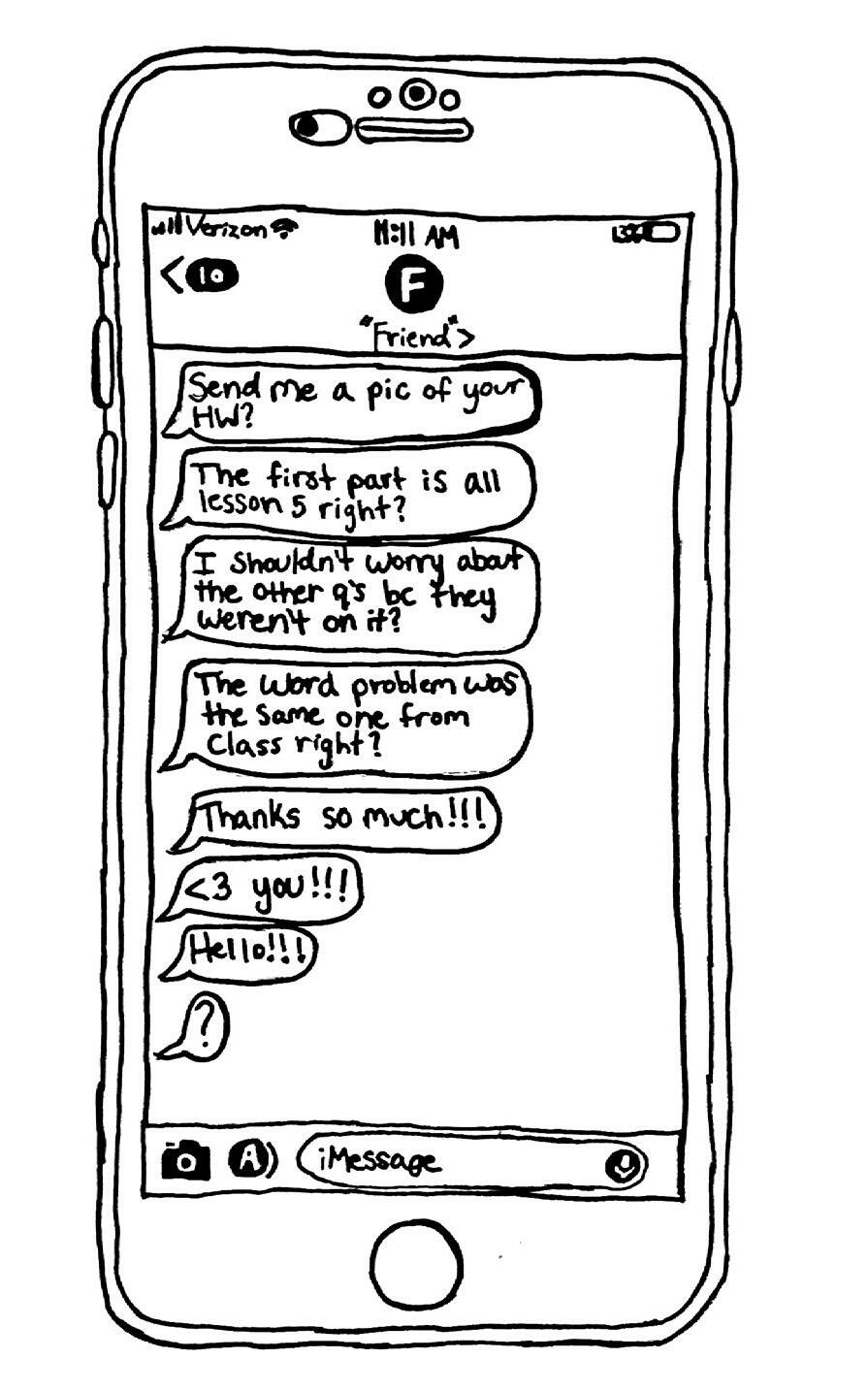
How does Oyster River define academic integrity? Do you know? What is academic integrity and why is it important? It’s alright if you don’t know the answers. Before this past fall I didn’t know the answers myself and I am willing to bet a lot of you are in the same boat.
In the summer of 2018, a group of faculty members
were tasked with reviewing Oyster River’s current policy on cheating and plagiarism and starting the process of designing a new policy. In response to receiving this responsibility, mem bers of the Academic Integrity Committee gathered students, differing in class and gender, to provide student perspective and ideas.
The committee was created by administration in response to the old policy on plagiarism, which lacked necessary specifics. As a student, I believe a large part of the problem begins with the lack of open commu nication between students and faculty on issues of academic integrity; more importantly, I don’t believe students know what academic integrity actual ly means and how important it truly is.
“The old policy is very vague, it’s almost nothing,” explains English teacher and Academic Integrity Committee member, Kara Sullivan. In this policy, if you get caught for plagiarism, you receive a zero for the assignment and if the behavior is re peated, you will fail the class. Sullivan says, “it doesn’t use the term ‘academ ic integrity’ which covers a lot more than plagiarism, and so we felt it was important for students and faculty members to be on the same page and hopefully we can help with that.”
One of the problems regarding the issue of academic integrity at Oyster River High School is that the lines can be intentionally blurred by students to justify their habitual cheating.
There are many reasons why students resort to cheating in our community, most of which deal with the fear of a de scending grade point average. I believe students have become more comfortable cheating within the high school due to the fact that there is no clear definition as to what cheating is. Be cause of this, students learn to justify their habits by claiming that they aren’t technically cheating, they are simply asking their friend what questions to expect on their upcoming math test. No big deal, right?
Wrong.
If you were to ask me to define academic integrity, I would
say that it is a blanket term used to describe the numerous forms of honest and moral behaviors regarding academics. This is a required skill not only to carry with you through high school but into college and even in life!
“I worry that students are coming out of high school not knowing what academic integrity means and also not understanding the gravity of it,” says Sullivan. “If you go to college, there is going to be a very clear set of rules and there won’t be any wiggle room. Should we have similar expectations?”
I myself had a limited understanding as to the importance of what academic integrity is to a school before writing an article centered around it. I hope that with the implemen tation of a new policy somewhere in the years to come, students can be introduced to a system where the policy is effectively communicated to avoid confusion, and to create understanding.
“I hope that we can make a policy that fits our school, but most of all, I want to make sure people know what the policy is,” states one of the four student representatives on the committee, Patty Andersen (‘19). “Right now, I don’t think if you talked to any student that that student could tell you what the policy is,” she says. “I probably couldn’t even tell you what it is, and I’m on the committee.”
To address the issue, I think having an active student
voice in the making of a new policy is essential to creating a comfortable atmosphere for these issues to be discussed and resolved. This also provides a student perspective that will be helpful in making sure the policy is effectively communicated to the student body while being represented on the commit tee.
The Academic Integrity Committee hopes to create a system where a student’s cheating history is documented.
“We want to make a central place where cheating and plagiarism can be reported, like a file system or something like that so that when a teacher is going through the process of the consequences, they can go through the file and see if this is the first time it’s ever happened - like it was just a mistake - or if it’s something that’s really ingrained within the student and needs to be dealt with.”
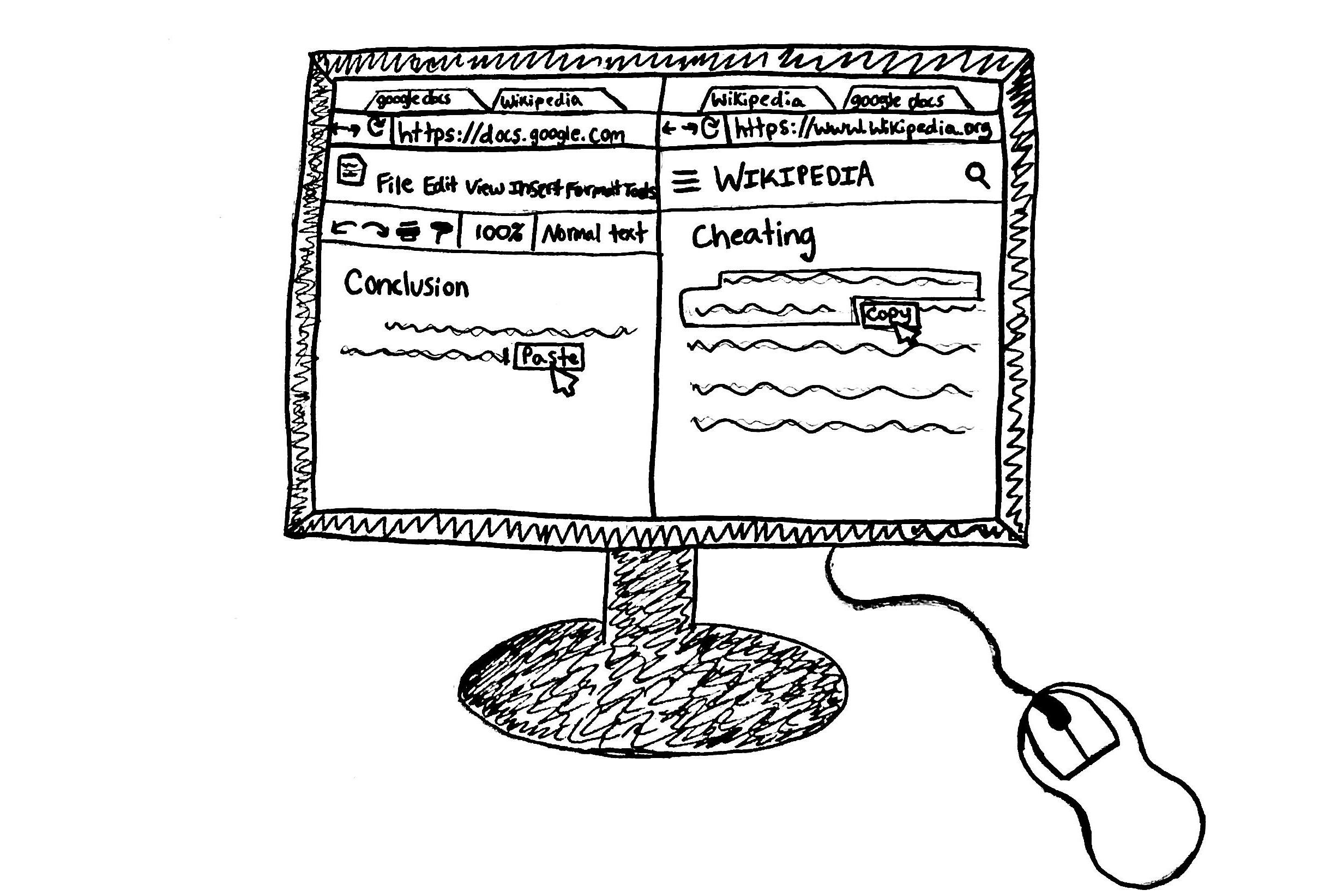
Aside from this, there are many other procedural ideas the committee is discussing currently. Regardless, they hope for a system where there’d either be a designated professional, or documented place teachers could use as resources when encountering issues with cheating in the classroom.
I think with an understanding of what academic integrity means to Oyster River High School as well as a newly devel oped policy with a clear definition as to what cheating and plagiarism are, the school can begin to see a positive change in its culture.
Theoldpolicy,whichcanbeaccessedthroughtheschoolwebsiteorinthestudenthandbook,says, “Astudentcommitsplagiarismif he/sheusesideasfromanotherpersonanddoesnotproperlycitethesource.Apapercontaining improperlyborrowedideaswhicharepresentedasoriginalthinkingisdishonest.Whethertheborrowingisintentionalornot,itis consideredplagiarism.Plagiarismincludes:1.wordforwordliftingof informationfromasource2.paraphrasinginformationwhich isnotcommonknowledge3.usinganotherperson’soriginalideabutdevelopingitwithdetails,examplesandfacts4.borrowingfrom anotherstudentorteacherwithwhomtheassignmentwasdiscussed.Plagiarismresultsinazerofortheassignmentand,depending uponthecircumstances,maycauseastudenttofaileitherthequarterorthecourse,evenforafirstoffense.Inaddition,anysubse quentoffensesmayresultindisciplinaryactionuptoandincluding,suspension.”
- Anna Sourdif ArtworkByAbbyCraig

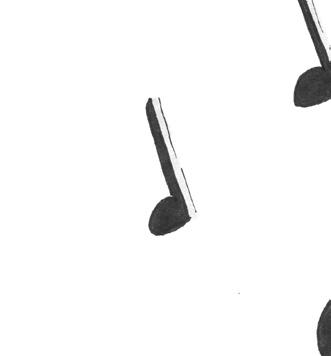







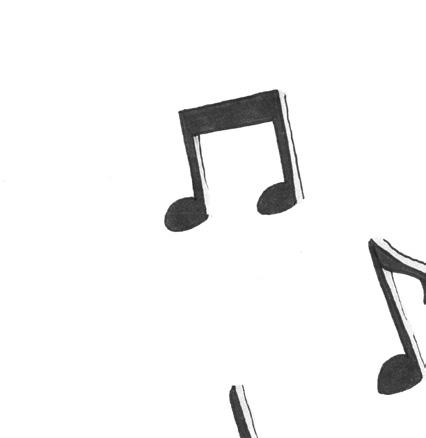
We all have them, we know they exist, and yet we keep them close to our hearts where nobody will ever discover them: musical guilty pleasures. To establish some trust here, I will tell you mine. I am a straight up ARMY. I listen to BTS (Korean pop band) daily, I’ve seen them in concert, I am following them on twitter and yes, I know the “fan chant”. But admittedly, this is uncomfortable for me to type into an article that I know is being published. So let me ask you, why? Why is it a shameful thing to enjoy the music from the biggest boy band in the world?
Some people might choose to keep the music they listen to or the genre they enjoy most to themselves; afterall, it can be a private thing. But because music can be so personal, it becomes easy for people to place judgement onto others who listen to different music than what is mainstream or socially acceptable in their eyes. These judgements can be


and welcoming way. Beaton and his advisory created what they call, “Album Club.” The group works on a rotation, that Beaton describes as working like a book club. A student picks an album, their peers listen to the album throughout the week, and at the end of the week they discuss their thoughts about the music.
Beaton describes his intention behind the creation of the club, “I try and find ways to connect with all of my students and for some of us, music became a common topic we could bond over. We all wanted to share our favorite bands and albums with each other. Out of this, our album club was born.”
Beaton credits Album Club to providing him new perspectives and strong relationships with the students in his advisory. “It gives us a way to share part of our selves through the art we love. Moreover, it catalyzes a path to
positive or negative, and depending on which type of judge ment is being made, it can bring people together or isolate them.
Carly Hoag (‘19) explains how some judgements can be positive. “For example, if you find out someone likes a band that you like, you can say to yourself, ‘oh that person might be a little bit like me,’” she says. “I definitely think people make judgements about other people based on their music preferences, and in cases like that it’s okay, but sometimes it’s actually negative and that’s not great.”
Kai Beaton, a paraprofessional at the high school, has created an environment for students to share music in a safe
love and understand new things we may have missed along the way.”
Sometimes we face judgement for what we choose to listen to; it has happened to me. I listen to a wide variety of music depending on where I am. I enjoy listening to classical music on rainy days but when the sun comes out I am blasting k-pop in my CRV and yes, I have been shamed for this.
“There is definitely [music] that I hide as my guilty pleasure--not going to lie, I like some good throwback Tay lor Swift,” confesses Sophie Moore (‘19). “I have an entire throwback playlist on Spotify just dedicated to her and
“Music is fundamental to the human experience. Though we may have different aesthetic interests, the overall joys of music transcend boundaries which may otherwise seem in surmountable.” - Kai Beaton
it’s
Moore expresses her fear of judgement even amongst her friends. “I have all of these playlists that have lit tle stars as their title. I want to make them secret because a lot of my friends go to my music and go to listen to what I’m listening to just to find new things, and I don’t want them to know that I listen to Taylor Swift every morning when I am doing makeup,” says Moore.
aaaaaWe all listen to music for a multitude of reasons. We enjoy listening to music be cause we like the way it sounds, or because of the way it makes us feel when the lyrics relate to our emotions, or how it rep resents our feelings in a lyrical manner. aaaaaImagine this: you are sitting in your car, on your way home from a hard day of work or school, and you’re exhaust ed. Then, all of a sudden, almost if by magic (or Spotify premium), the perfect song comes on. I can’t speak for you, but the feeling I get when that happens is unattainable without the presence of music. No matter how you put it or how you use it, music is an outlet for expression that we all utilize in different ways and in varying forms; I know I use it for this purpose.
“Music is just so personal, and sure, we listen to it because it sounds good--but we also relate to what we listen to,” explains Hoag. “It can be something that relates to what you’re going through in your life or experiencing and that’s why it’s really disappointing when people judge you for liking a song you like because you may have a personal connection to it.”


However, when you find people who like the same mu sic that interests you, the feeling is extraordinary. If you are anything like myself, you may have looked around and wondered what other people are listening to. I am not someone who thinks there’s only one genre of music an individual can listen to. In fact, I myself listen to a wide range of artists spanning from BTS to Frank Sinatra, and I am sure there are others in the school who could say the same (maybe not … but you never know!).
I think this is something that should be embraced. We are not limited to one genre of musical preference and those genres don’t define who we are!
“I really like jazz. I am a big fan of jazz singers and I like stuff from the 60’s and 70’s especially,” express es Hoag when discussing her favorite genres of music and why they are her favorites. “When the country was changing during the Vietnam War, people had a lot to say especially about the things they believed in and they used music as their voice. Music from those really transforma tive times is really powerful, and I just love how it sounds but it’s also really amazing to hear the words that they are saying.”






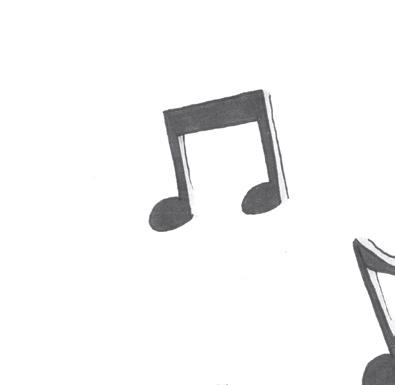
Beaton concludes by providing his thoughts on why music is important to Oyster River, “music gives students a way to cope, a way to express themselves, a way to un derstand new ideas, and it gives them a way to have fun. No matter our age we are really all students. We continue to grow and learn about ourselves and the world around us.” He continues to say, “music resonates deep with in our DNA. It could be considered the pulse of human culture - the rhythms and melodies which score our experiences. I encourage everyone to open their minds to experiencing new music for with it comes new perspectives.”
Music can bring people together in unique ways that, with the fear of judgement, can’t otherwise happen. It’s important in all walks of life to be yourself, but I’d encourage everyone to at the very least be honest about your musical guilty pleasures. After all, we all have them.



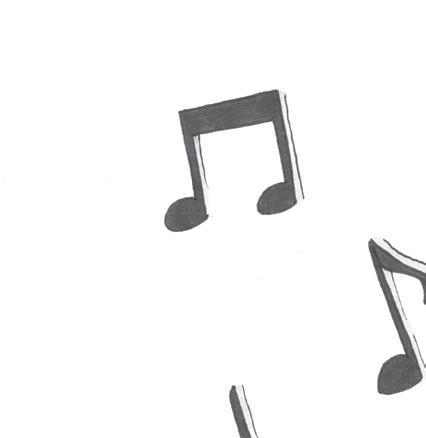






 Artwork by
- Anna Sourdif
Hambucken and Cam St. Ours
Artwork by
- Anna Sourdif
Hambucken and Cam St. Ours
normally my morning get ready playlist because she hypes me up.”Charlotte
Hitting a batting average of .400. Getting a total of 100 points during junior year. Making an average of 12-15 saves per game. Being in the Head of the Charles Regatta. Getting 1,000 assists and 500 digs. Earning All-State First Team. These are some of the accomplishments that nine Oyster River students-athletes have achieved during their high school athletic careers. This upcoming year, these athletes will be moving on from ORHS sports to NCAA Division I, II, or III programs. This article will highlight their process of getting to this point.
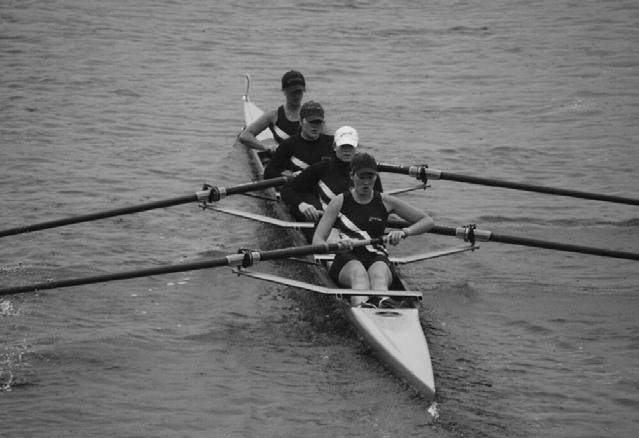
Max Lewis will be playing Division III baseball at Nichols College in Dudley, Massachusetts. After committing in August of 2018, Lewis felt a great sense of relief, especially because of how many years he devoted to refining his skills and attending showcase tournaments all over the nation.
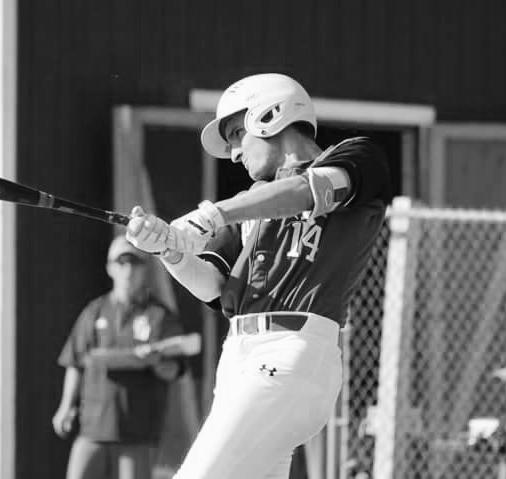

Lewis has been playing baseball ever since he was four-yearsold. His older brothers convinced him to play and soon after, they all quickly bonded over the sport. After a few more years of playing, Lewis noted, “I knew I wanted to play sports in
Gabbie Haug will be playing Division III lacrosse at Lycoming College in Williamsport, Pennsylvania. Haug never expected herself to become a committed lacrosse goalie. She expanded upon this, saying: “I never really thought about competing at the collegiate level. But, later on, I realized that I had the skills to play at that next level.”

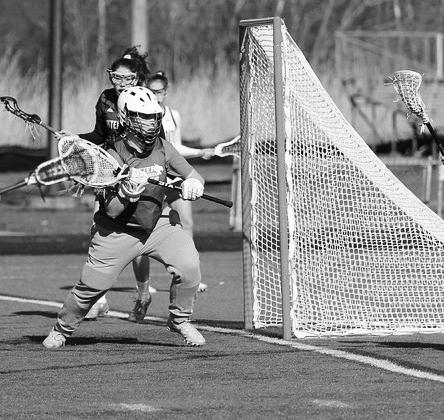
Not only did Haug never see herself becoming a college commit, but she also originally did not even consider playing lacrosse. Haug was already invested in her field hockey career, being one of the key field hockey goalies on her team, and prioritized that over all other sports. Because of her impressive skills as a field hockey goalie, Haug was approached by a few of her teammates to become a lacrosse goalie in seventh grade. From her experience in field hockey and dedicated attitude,
college since elementary school. Later on, in eighth grade, was when I learned what commiting really was. At that moment, I knew that’s what I wanted to do.”
This long-lasting dream of playing a collegiate sport was further solidified because of his interest in playing baseball at a higher level. “I always knew I wanted to commit for one of my sports whether it be baseball or basketball. That’s just what I do. I play sports and I didn’t want that to end after high school. I have always wanted to play at the highest level I can.”
As Lewis approaches his first year of collegiate sports, he hopes to push himself to be able to match and exceed the higher level of athletics right from the start. “I hope to get playing time my freshman year and even become a starter in the field, along with becoming a relief pitcher. I also hope that we win our division before I leave the school.”
Haug quickly became skillful and has stuck with lacrosse ever since.
As her interest in lacrosse grew, she decided to join a club lacrosse team, Houlagan Lacrosse. This exposed her to a number of colleges including Rivier University, Hood College, Bay Path University, University of New Hampshire, and Plymouth State University. This led to her making a hard decision between Becker College, where she could play both lacrosse and field hockey, or Lycoming College, where she could just play lacrosse. Although, she said, “Lycoming had that something special about it that just made me really like it.”
Haug is content with her decision and is looking forward to the next step as a collegiate athlete and noted that: “I am just smiling thinking about it. I was so relieved when I committed that I even started to cry after realizing the hard work that I, my family, my friends, and my teammates put into helping me. All of that has finally paid off.”
Madi Brown-Bloom will be playing Division III softball at Elmira College in Elmira, New York. Prior to her junior year of high school, Brown-Bloom never expected herself to become a committed athlete. Although, she noted: “I just had this realization at the end of my junior year that softball is a big part of my life and I don’t think I would enjoy college as much without it.”
With both of her parents being former softball players, Brown-Bloom fell in love with the sport at a young age. As soon as she realized she wanted to commit in the fall of her senior year, she focused on making recruitment videos and reaching out to a number of coaches. Despite starting the recruiting process a little late, Brown-Bloom was eager to reach out. “Since

Becca Shay will be rowing at University of Massachusetts Amherst, which is a Division I university. After initially being uninterested in continuing to row in college, Shay’s mindset significantly changed in the fall of her junior year of high school. She highlighted this, saying, “going into the process, I didn’t see myself committing. I was back and forth deciding, but now, with it being senior spring, I am more excited than ever. It hit me this spring that it was something I absolutely wanted to do.”
Shay started rowing in eighth grade for the Great Bay Rowing team. After having a positive experience on her team for the next few years, Shay’s interest in rowing grew. This was when she realized she actually wanted to row in college. Shay expanded upon this, saying, “I have realized that rowing is going to be a part of me forever. I have always been active, always
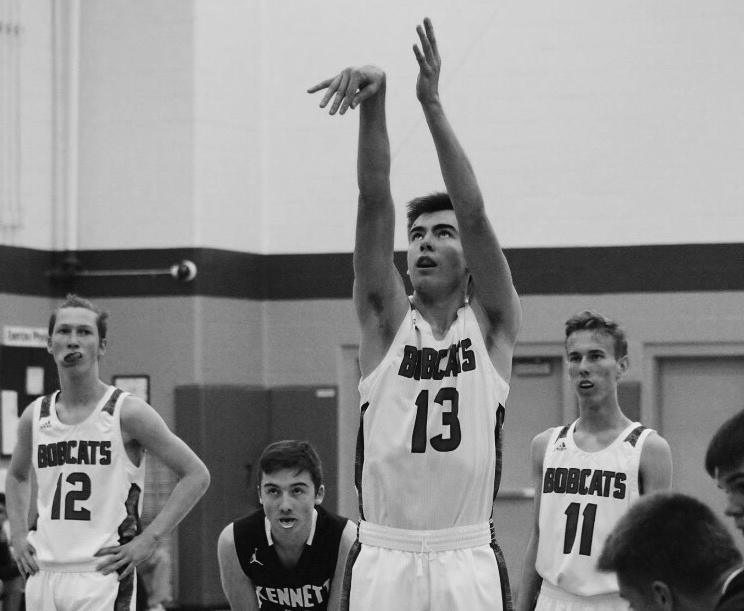
I started the process so late, a lot of Division II teams already had their 2019 recruits picked. This was discouraging, but I kept looking and realized that Division III would be a better fit anyway,” stated Brown-Bloom.
Through time, she found Elmira College. Her commitment came with a great sense of relief and a desire to work even harder on her club team and her high school team. “After meeting with several coaches over the summer and meeting different softball teams, I knew that Elmira would be the best fit for me,” said Brown-Bloom.
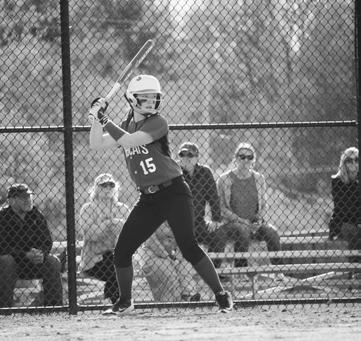
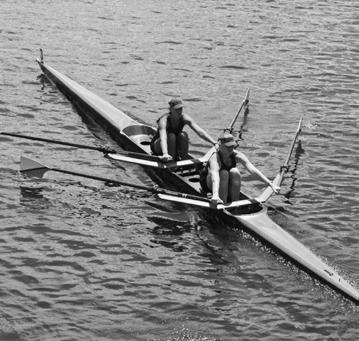
After realizing this, Brown-Bloom detailed how excited she is to compete at a collegiate level and experience softball in a new way. “In college, I hope to stick to my academics while also playing softball. I also hope to really focus on getting all of my reps in and getting stronger for the season.” She added, “it can be a lot of pressure to excel at a sport when you are committed for it in college, but it’s important to realize that everyone has their ups and downs.”
been involved in a sport each season so it was a no-brainer that I wanted to commit to a school and continue rowing,” said Shay.
Shay made an effort to connect with various college coaches to become more familiar with what she was looking for in a team and a school. This included creating a rowing resume that summarized all of her accomplishments, emailing coaches, talking with coaches over the phone, and meeting the coaches during campus visits. During this process, Shay connected with the coach at University of Massachusetts Amherst, gaining the opportunity to go on a recruitment trip. Shay was then able to meet the team, and attend one of the teams’ practices. After this, Shay realized that University of Massachusetts Amherst was the best fit because “none of the other schools I applied to had everything I wanted in a college experience so it was an easy choice.”
After spending quality time with the team, Shay is the most excited she has ever been about her commitment to the school. She said she hopes to “get stronger, faster, and become an overall better athlete and rower.” She added: “I am so excited! It is a new chapter for me and I am excited for what it entails.”
Allison Marshall will be playing Division III lacrosse at Assumption College in Worcester, Massachusetts. After starting her lacrosse career at the age of seven and playing for three years on the Oyster River Youth Association (ORYA) Boys Lacrosse team, Marshall continued her career on the girls ORYA, middle, and high school teams for nine more years. Now, she is excited to continue in college. Marshall was one of the first girls to start playing lacrosse in the Oyster River Cooperative School District and has been one of the key midfielders for her team throughout her career. Marshall is not only involved with her local lacrosse program,
Ana Szymanski will be rowing at Fairfield University, which is a Division I university in Fairfield, Connecticut. Szymanski has always wanted to become a collegiate athlete and highlighted this, saying, “being a collegiate athlete was always a dream that I had in the back of my mind since I was younger. Being able to proudly say that I am following through with that dream is something that I couldn’t be more excited about.”
Alongside Shay, Szymanski is a part of the Great Bay Rowing team. “Being a part of this team has been by far the highlight of my high school career and being a part of a club team has opened up many doors for opportunities and new friendships,”
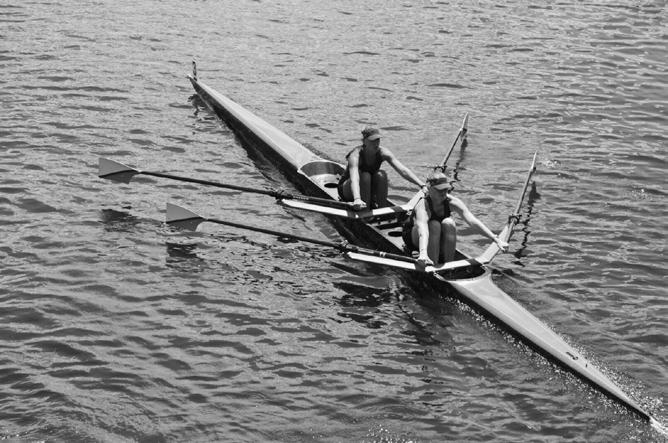
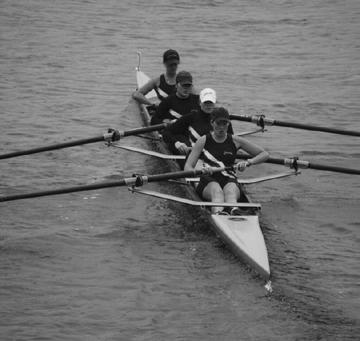

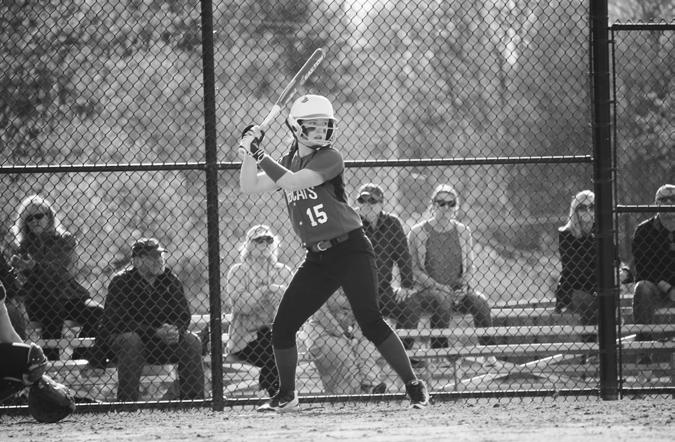
but is also a part of a lacrosse club team, Granite State Elite Lacrosse.
Marshall was scouted by several college coaches at the various showcase tournaments she has attended all over the nation with her club team. After connecting with a few coaches and narrowing down her options with the help of her club lacrosse coach, she made up her mind. “I realized I didn’t want to go far from home and Assumption met all the requirements I was looking for,” said Marshall.
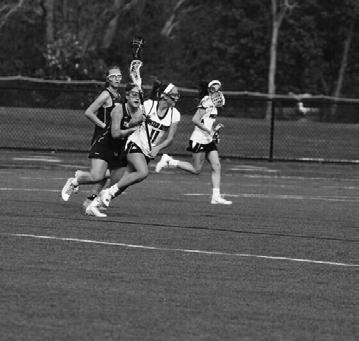
As an Assumption lacrosse commit, Marshall said she hopes to: “prove to myself and push myself to improve every day. I will work hard on and off the field, while bonding with the team, and keeping up with my school work.” She added that she is looking forward to creating new friendships, continuing to play lacrosse, and starting a new chapter in her life.
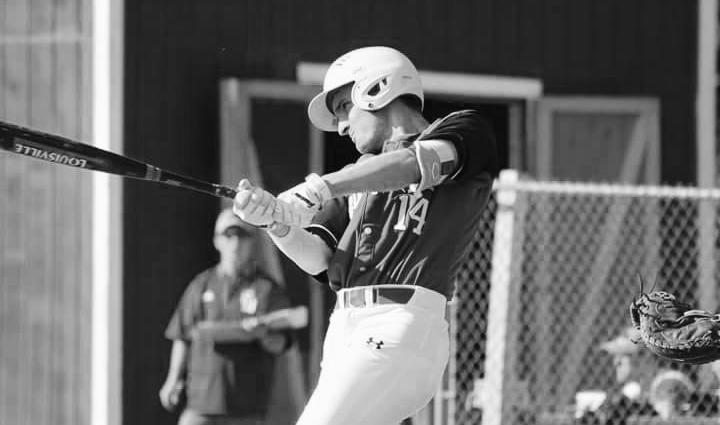
said Szymanski.
These opportunities include connecting with various college coaches from several schools such as Fairfield University, Loyola University of Maryland, Boston College, and Villanova University. Because of these options, Szymanski had to make one of the hardest decisions of her life of deciding to attend Fairfield University or Loyola University of Maryland. Although, Szymanski noted: “after I finally made the decision to attend Fairfield, I instantly felt a weight lift of my shoulders and I knew I was making the right decision.”
This decision became even more definite after having an official visit with her new coaches and teammates. Szymanski said she is looking forward to building upon the connections she initially established at her visit to the university, along with, “making a positive contribution to the team, both in regards to athletics and character,” said Szymanski.
play in college because I always watched March Madness and North Carolina and it looked like they were having so much fun.”
Because of this, Landrigan responded to a few coaches who had shown interest in him. Although, he mentioned that his recruiting process was fairly easy because “Colby-Sawyer was basically the front runner the entire time because they were constantly in contact with me,” said Landrigan.
Landrigan emphasized that basketball has always been a major part of his life. He did not want his basketball career to end after high school because of how many years he has already devoted himself to the sport. Along with this, Landrigan wanted to follow in his father’s footsteps as a collegiate basketball player. He added to this, saying, “it has always been a dream of mine to
After his commitment, he said: “I am so excited to play there next year because I get to build new relationships with the coaching staff and my teammates. And I’m happy that my basketball career won’t end after high school.”
Alongside making new connections, Landrigan noted that: “I am going to try to take in as much as possible from the upperclassmen and coaches so that I can be the best player possible.”

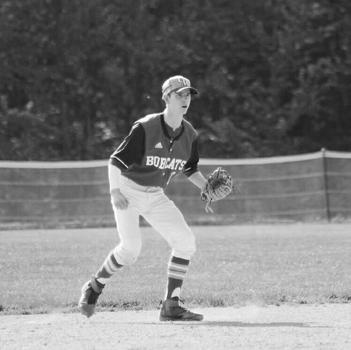
Owen Tonkin will be playing Division II baseball at Southern New Hampshire Uni versity in Manchester, New Hampshire. Tonkin’s childhood dream of playing in the Major League has become even more promising after his commitment.
Tonkin started playing baseball at a very young age and comes from a family of serious Red Sox fans. As Tonkin ma tured as a player, his skills improved. One of his best seasons was his sophomore year in high school, which led to him being in contact with a number of Division I schools.
Although, unfortunately, in the first scrimmage of his junior year, he was hit with a line-drive. Soon after, he realized he had
Cassidy Gibb will be playing Division III volleyball at University of Southern Maine in Portland, Maine. After initially being skeptical about playing volleyball, Gibb decided to join her first team at the age of eight. This decision was influenced by her elementary school principal, who was heavily involved with the athletics program and thought Gibb would be a good fit to the team.
Soon after starting, she fell in love with the sport and joined a club team, Great Bay Volleyball. Gibb noted that it was at this time that, “I knew after I had started playing that I wanted to play at the college level, especially once I had become serious
broken his hip. “The recruiting process had been going so well for me and then I hit the biggest speed bump. There were quite a few times where I was just at the point where I wanted to commit to a local DIII program. But, at the same time, I had always had higher aspirations.”
Despite the setback, Tonkin rebounded well and continued to reach out to schools into his junior and senior year of high school. He found Southern New Hampshire University and was impressed with their academics as well as their athletics. Tonkin highlighted, “the coach at SNHU was one of the main reasons I decided to commit. He is a great coach and is talked highly about by the players. He is very personable and all of the players love to play for him.”
Tonkin is looking forward to building upon these con nections and hopefully earn playing time his freshman year. Through college, he is also looking to become progressively more prominent in the baseball program at SNHU.

about it. Ever since I started, I’ve always been very passionate about volleyball, so it’s hard to imagine my career ending after my high school season.”
Gibb started her recruiting process early. She highlighted that ever since her freshman year of high school, she has explored recruiting websites, and has uploaded films, pictures, and newspaper excerpts to her online sports profile. This led to her connecting with various coaches, and later, was between University of Southern Maine and University of New England.
Gibb noted that her commitment to University of Southern Maine was an easy decision after touring campus and meeting the team. She said, “I’m very excited and surprisingly not anxious at all. The nerves might kick in closer to move-in, but right now, I can’t wait to make the transition.” She added, “I am looking forward to playing with a new team, working hard, and being a good teammate above anything.”
All of these student-athletes have worked hard throughout their athletic career, and have devoted a great amount of time and energy to their respective sport to be where they are today. Lewis highlighted this, saying, “the journey from being an average kid that liked the game of baseball to being a college commit took years of dedication.” He continued, saying, “it took years before a college coach even looked at me. But, all of the time dedicated to the sport really paid off.”
- Abby SchmittFirst Page: Photo by Colleen Oxford, Arleen Alphonse, Sherri Bloom & Milissa Gass
Second Page: Photo by Arleen Alphonse, RB Laurence, Jesse Morrell, Colleen Oxford, Bain Testa
The end of an athletic journey for high school athletes is marked by the final buzzer, the last out, or the ball hit ting the court one last time. Most Oyster River athletes will never again wear “Bobcats” across their chest or ride a bus up Route 4 to play in a rivalry game. This includes the vast majority of former student athletes, with the exception of a few. Those who come back to continue chasing state championships and spend even more time attempting to master the art of sleeping while on a bus ride to Hanover. These former athletes don’t return in their former role however. They return to a new role, as coaches.



In the past decade, Oyster River athletics has seen a growing occurrence: student athletes returning to the programs they once competed for. Currently, ORHS alumni can be seen on the sidelines of 10 sports, span ning all three seasons. When I first observed this trend across multiple of our athletic programs at Oyster River, I was very intrigued. I looked at some of the most mem orable or influential coaches in my life and realized that they were often former Oyster River athletes. I was in terested in seeing why so many athletes wanted to return as coaches and what impact they had on the community. So, I asked. I talked with a handful of coaches to see why they returned to Oyster River, as well as with adminis trators, coaches, and athletes to see what impact these coaches have.

One of the biggest impacts they have is on their ath letes. These coaches have played on the same fields, been in the same classrooms, and had many of the same teach ers as many of their students-athletes. Andy Lathrop, Oyster River High School Athletic Director, talked about how valuable coaches who return to their programs are. “They know and understand the culture of the school. They understand the community and what its like to be

an athlete here,” Lathrop said.


Administrators and athletes alike have seen the im mense impact that these coaches can have. They are able to connect with their athletes in ways that other coach es can not. Emily Shuman (‘20) has had multiple track coaches who have formerly competed for Oyster River. She said that, “coaches who have previously gone to Oys ter River bring a perspective that the other coaches can’t. They come in knowing exactly how we feel because they did it themselves not too long ago.”
Many of these alumni return to work with their for mer head coaches. In the past few years, both boys basket ball as well as track and field has seen numerous athletes come back to work with head coaches, Lorne Lucas and Nick Ricciardi, respectively. “I look at the basketball situational and see that [half] of the coaches played for Lorne. That tells me they had a great experience with him and they learned a lot about coaching from him,” said Lathrop.
This past season, four of the five coaches on staff for the boys basketball team were former players: Paul Bam ford, Zach Lewis, Peter Antognetti, and Devin Sawtelle. Kyle Landrigan (‘19), captain of the boys basketball team, noted that these coaches are invaluable to the program. “It’s great having coaches that played for Coach Lucas because they know the playbook by heart and can help all the young guys learn it.”

This continuity that occurs in the basketball program can also be seen on the track team. Ricciardi has seen 5 of his former track athletes return as coaches in the last couple of years. Ricciardi said that these coaches, “know the program and culture. They know how things run, the expectations, and the responsibilities of both the coaches and the athletes.”
I talked with 5 of these former athletes and asked them a series of questions about how they got into coaching, their favorite high school memories, and ultimately what made them want to return to Oyster River as coaches.

In her second year as head coach of the girls varsity basket ball team, Casimiro returns to Oyster River after going unde feated and winning the state championship her senior season. Casimiro continued her athletic career at Mount Ida College in Newton, Massachusetts. Casimiro is revitalizing a program that has seen a nine win increase between her first two seasons as head coach. She noted that the largest factor for her wanting to return was to be able to give back. “I felt compelled to give back to the community that gave me so much. I know how much a coach can affect you, for better or for worse, and I wanted to be able to give students a positive experience that they can re member and then carry over to others,” she said. While in high school, Casimiro also ran cross country and track. Beyond the state championship campaign and undefeated season, Casimiro recalls her favorite high school memories as the, “bus rides, team sleepovers, spaghetti dinners, and breakfast trips.”
Lewis joined the boys basketball coaching staff after a high school career ending in state championship defeat. “That night we lost, I told myself I’d be back to help a team win the champi onship,” he said. Lewis just concluded his third season as a part of the boys basketball coaching staff. While at Oyster River, Lewis found a sense of family that he wanted to foster in the next generation. “It’s one of the greatest things about that bond between teammates. It doesn’t matter if you hated each other off the court, you were family on it. That sense of family was something that disappeared from ORHS for a while,” said Lewis. After graduation, Lewis attended St. Joe’s College of Maine where he pursued a degree in English Literature and Secondary English. Lewis noted rivalry games against Coe Brown as his most memorable moments while competing at Oyster River.
Swett was a two sport athlete at Oyster River, playing both volleyball and softball. She returned to coach the girls volleyball team. She credits her high school coach as a large contributor for her desire to coach. “He was this little tiny man who re mains one of the greatest influences on my life. He had a way of commanding respect and getting you to perform to your highest level, all while letting us continue to love the game we were playing. I think he was my inspiration for wanting to coach,” she said. Swett joined the former head coach as an assistant and
made the natural transition to head coach upon his departure. While at Oyster River, Swett recalls her softball team’s improb able playoff run as one of her favorite memories. “We were the 16th seed and played Somersworth, our number one rival and the 1st seed. We beat them! We then went on to beat the number five seed before being eliminated. It was a great group of girls who never gave up.”
Peter Antognetti (‘15)
Antognetti took a more indirect route back to Oyster River. As a recent graduate of UNH, Antognetti did the entirety of his coaching responsibilities as a full time student. He was originally hired by former athletic director, Corey Parker, to run the clock at both middle school and high school games. Antognetti was then approached by his former coach about the reserve coach ing position. “I never thought the opportunity would present itself so early on in life, but there was no way I could pass up the chance to get my coaching start at my alma mater. That’s the dream job for any coach, regardless of the level,” he said. Similar to many others, Antognetti’s favorite high school athletic memories are of victorious rivalry games. He recalls coming off of the opponent’s court saying, “there was no better feeling than walking off their home court, leaving their student section silenced.”


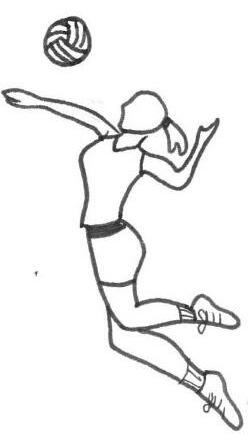





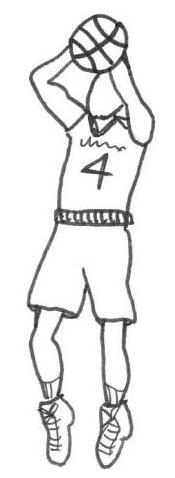
Beaton, the boys assistant varsity soccer coach, caught the coaching bug after he was invited to one practice by then assis tant varsity soccer coach and former ORHS teammate Jake Bav er. “During that first practice, I felt an immediate rapport with the team and knew it was going to be something special. As time progressed, I found my role as a player’s coach. I was someone to keep the emotional psychology of the team functioning, some one to listen, someone to motivate, and someone to be a conduit between coaches and players,” he said. He competed in soccer, lacrosse, and cross country while at Oyster River. Beaton was a part of many successful teams and championship runs while at Oyster River, but he says what stands out the most are the, “last ing memories, the relationships, and life lessons gained through the experience.” Beaton concluded by saying, “the reasons which compelled me back the most were those of community, a love for teaching, and a desire to put my energy towards helping others.”
Coaches return to Oyster River for a wide range or reasons. Whether it be a lifelong desire to be on the sidelines or one practice that developed into many more, student athletes seem to be finding their way back to the high school to take on new roles as coaches. Lathrop concluded by saying ultimately it is, “a testament to the quality of the programs [at Oyster River] and the experience [athletes] had when they were here.”
- Joe Morrell Artwork by Chloe Jackson“Fashion is a bit of a silent conversation. It’s our public projection of ourselves; it adds to, enhances, confuses, and challenges people’s perceptions of us. For some reason, we rarely compliment each other. Fashion is the big exception. I love that we feel comfortable compli menting each other whether we’re strangers, friends, or random acquaintances. It gives us an accessible start to any conversation and a way to recognize and admire each other.”
-Emma Hilary Gould (‘19)When we are little we dress up as someone we want to be -maybe a superhero or a princess. The same thought can carry over into our adult years when we ‘dress for the job we want not the job we have’ and wear a suit to interviews. Fashion can be a way to connect with others, express yourself, and feel your best. It’s only when we make assumptions about people based on fashion that the interest becomes toxic. This side of fashion, along with the consumeristic and wasteful nature, creates the public opinion that an interest in fashion is shallow. As Eleanor Zwart reported in “Second Hand Clothing” 75% of clothes go to landfills” - Howev er, there’s more to it. Having an interest in fashion doesn’t always mean buying new clothing all of the time. It can mean thrifting, recycling material, or simply working with what you have in your closet!
My fashion progressed from princess dresses, to aeropostale shirts and ugg boots, to colorful basics today. Although my taste has changed dramatically, the way fashion has connected me to others hasn’t. Recently, I went to an accepted students day event at a university and another girl there complimented my pants... which led to us getting breakfast together the next day! Even though complimenting someone’s clothing is a surface level inter action, it allows for deeper connection to follow.
Tucker Henry (‘19) says that he has started many conversa tions with people wearing shirts with his favorite sports teams and locations. “If I ever wear New England or university apparel to an airport, I end up in conversations with people I never would have met otherwise.”
For Andrea Drake, an ORHS Math Teacher who frequently designs and sews her own clothing, connection through compli menting someone’s clothing has sparked conversations comparing and contrasting styles, or philosophies regarding what fashion is to one another. “Conversations can spark about deeper issues like sustainability through textiles, the growth and waste of mass production, the reinforcement or rejection of gender norms/ste reotypes, or standards of beauty,” she says.
On the other hand, fashion’s ability to reject or reinforce ste reotypes is a double edged sword. Gould says, “given that fashion is so entwined with beauty standards, stereotypes, and socio economic conditions, we can fool ourselves, believing we know someone fully when we only know their clothes—clothes that may be more indicative of their life situation than their personality.”
With social media influencers frequently wearing Gucci and other designer brands, it’s easy for onlookers to feel bad when they can’t afford the items they see idolized people wearing. Some times I catch myself thinking I’d feel or be treated differently if I also presented myself that way.
“I hate that the way I dress affects and reflects my mood but it’s true. [The industry] lulls us into believing that we can change who we are from the outside in. It turns an image into a feeling. I think it’s critical to remember that how we dress only affects our mood if we buy into that idea,” Gould says.
The sayings “dress to impress” and “dress the part” do hold true for me. I like to dress up for presentations, interviews, and even important tests; I feel more prepared. Five studies published in, “The Cognitive Consequences of Formal Clothing,” by Colum bia University agree with this. The studies found that wearing formal clothing enhanced cognitive abilities.

Another study from the Journal of Experimental Social Psy chology found that when participants wore a white coat that they thought was a doctor’s, their ability to pay attention increased. However, if they wore the same coat but were told it was a paint er’s, wearing the coat did not result in that improvement, accord ing to “Mind Games: Sometimes a White Coat isn’t just a White Coat,” from the New York Times. This shows that the effect cloth ing has seems to be related to what we associate the clothing with. In fact, “we can learn a lot about past societies and cultures by the way they dressed, what textiles they used, what aspects of the body they elected to highlight, protect, or disguise,” says Drake. With so much weight on what we associate different clothing with, it’s time we look past its superficial qualities.
Nate Oxnard, ORHS science teacher, usually dresses formally for school. “To me, one’s dress sets the tone for an activity. I guess it’s a way of saying that I take learning seriously and that I have expectations that students in my classroom will as well. I think that is reflected in how I choose to present myself,” he says. In my experience, dressing formally isn’t necessary for teachers to set a serious tone, but it does make an impactful first impression.
Although Oxnard dresses formally to set a tone, he can can relate to the issue that the industry promotes changing from the outside-in. He says, “confidence comes from pushing myself, and trying something new or difficult. I’ve always thought that confi dence comes from the inside.”
For many people, like Oxnard, fashion is a way of presenting yourself. However, I think sometimes it’s less about a facade, and more a reflection of my mood. I find that the amount of effort I put into getting ready in the morning tends to set the tone for the rest of the day. According to a study from the University of Hertfordshire in Britain, I’m not alone. 57% of women tended to wear baggy tops when depressed, compared to 2% who tended to wear one when feeling happy. 62% tended to wear a favorite dress when happy, compared to 6 percent when sad.
“Many of us dress each day in what suits our mood, some people to the point where it’s difficult to pick out clothes to wear the night before because we don’t know how we’ll be feeling in the morning,” says Kelly Sinclair, Independent Stylist for Cabi, a clothing brand.
At the end of the day, how we dress holds a lot of weight whether we like it to or not. It gives the first impression of who we are and what we stand for, it teaches us about different past and present cultures, and it even impacts our mood. Let’s harness these aspects of fashion while working to improve the sustainabil ity, and socioeconomic indications in the industry.
-Phoebe Lovejoy Artwork by Phoebe LovejoyGreat Bay CrossFit’s High School Strength and Condition ing program is the perfect solution for preparing yourself mentally and physically for your sport. With our customized programming and attention to detail, you will be making progress with every workout, while staying injury free. Email us for more information: info@greatbaycrossfit.com

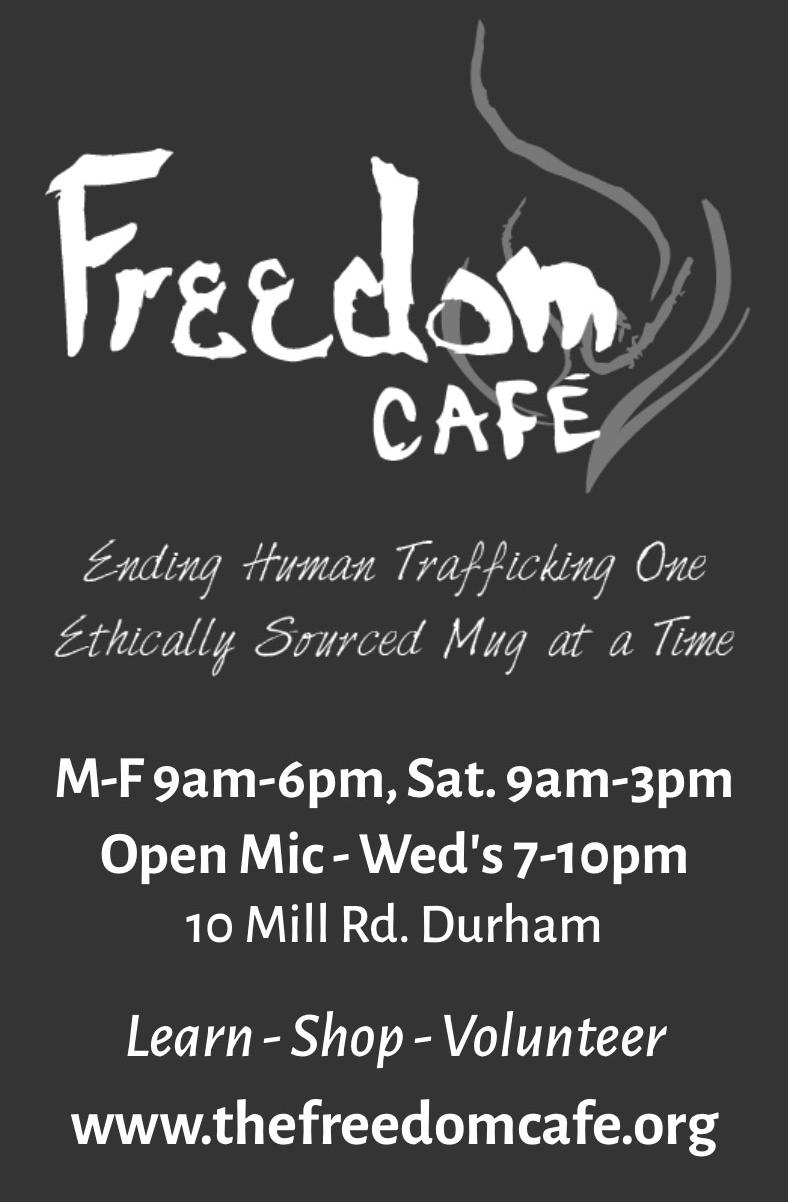
30 years of teaching experience in the Oyster River School District

One-shot, short, or long term assistance available this summer and next school year soozrenner@gmail.com CONGRATS TO THE CLASS OF 2019!

